Abstract
OBJECTIVE: To determine the benefits of early photocoagulation in patients with type I versus type II diabetes. DESIGN: One eye of each of 3,711 patients was randomly assigned to early photocoagulation; the other was assigned to deferral of photocoagulation, with follow-up visits scheduled every 4 months and photocoagulation to be carried out promptly if high-risk proliferative retinopathy developed. Patients were categorized by age and type of diabetes. MAIN OUTCOME MEASURES: Best corrected visual acuity was measured at each study visit scheduled at 4-month intervals. Stereoscopic fundus photographs were taken and evaluated at baseline, 4 months, and yearly thereafter. Retinopathy severity was assessed from fundus photographs. Severe visual loss was defined as visual acuity of worse than 5/200 for at least two consecutive study visits. RESULTS: Previously published results of the Early Treatment Diabetic Retinopathy Study (ETDRS) demonstrated a statistically significant benefit of early photocoagulation in preventing severe vision loss. Further analyses demonstrate that this benefit of early photocoagulation is greater in patients with type II diabetes than in those with type I. The relative benefit of early photocoagulation in patients with type II diabetes is also seen for other outcomes (development of high-risk proliferative retinopathy, development of the combined end point [severe visual loss or vitrectomy], development of moderate visual loss, or development of legal blindness). The patients most likely to benefit from early photocoagulation had severe nonproliferative retinopathy or early proliferative retinopathy. Analyses from the Diabetic Retinopathy Study confirm the relative benefit of scatter photocoagulation for type II patients. Because of the high correlation between age and type of diabetes, analyses sub-grouped by age show similar results. CONCLUSION: These analyses suggest that patients with type II diabetes, or older patients with diabetes, are more likely to benefit from early scatter photocoagulation than patients with type I diabetes. The current standard of care is to initiate scatter photocoagulation as the severity of retinopathy approaches or reaches the high-risk stage, Provided careful follow-up is possible, ETDRS data do not show that initiating scatter photocoagulation prior to the development of high-risk proliferative diabetic retinopathy in patients with type I diabetes will reduce the risk of severe visual loss. ETDRS analyses do indicate that for patients with type II diabetes, it is especially important to consider scatter photocoagulation at the time of the development of severe nonproliferative or early proliferative retinopathy.
Full text
PDF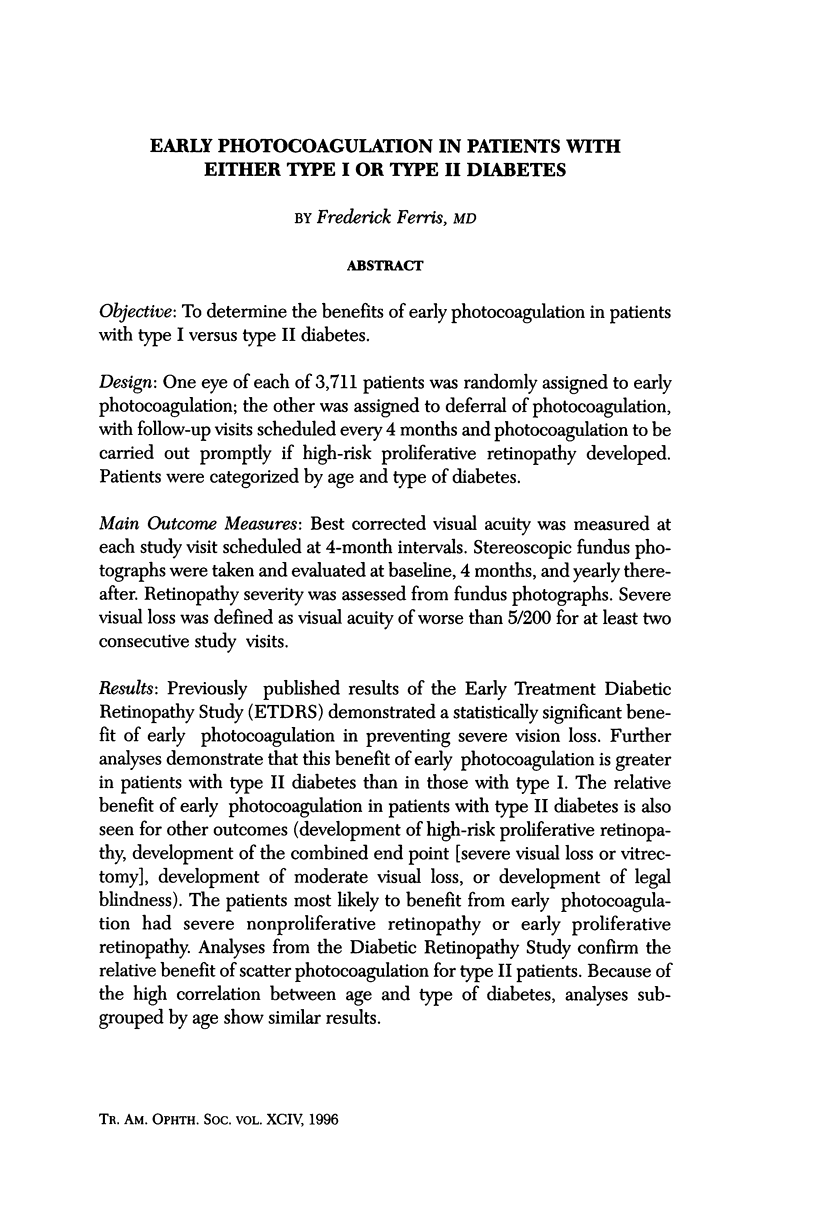
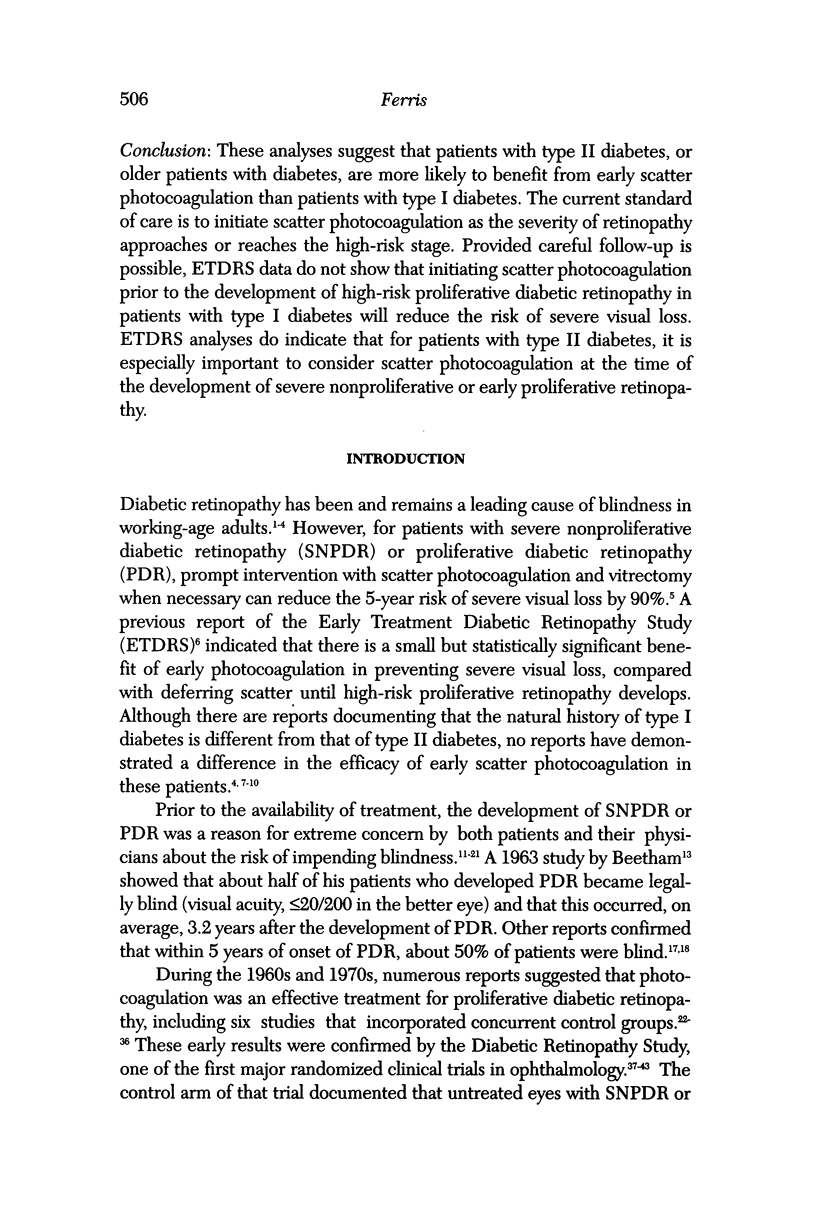
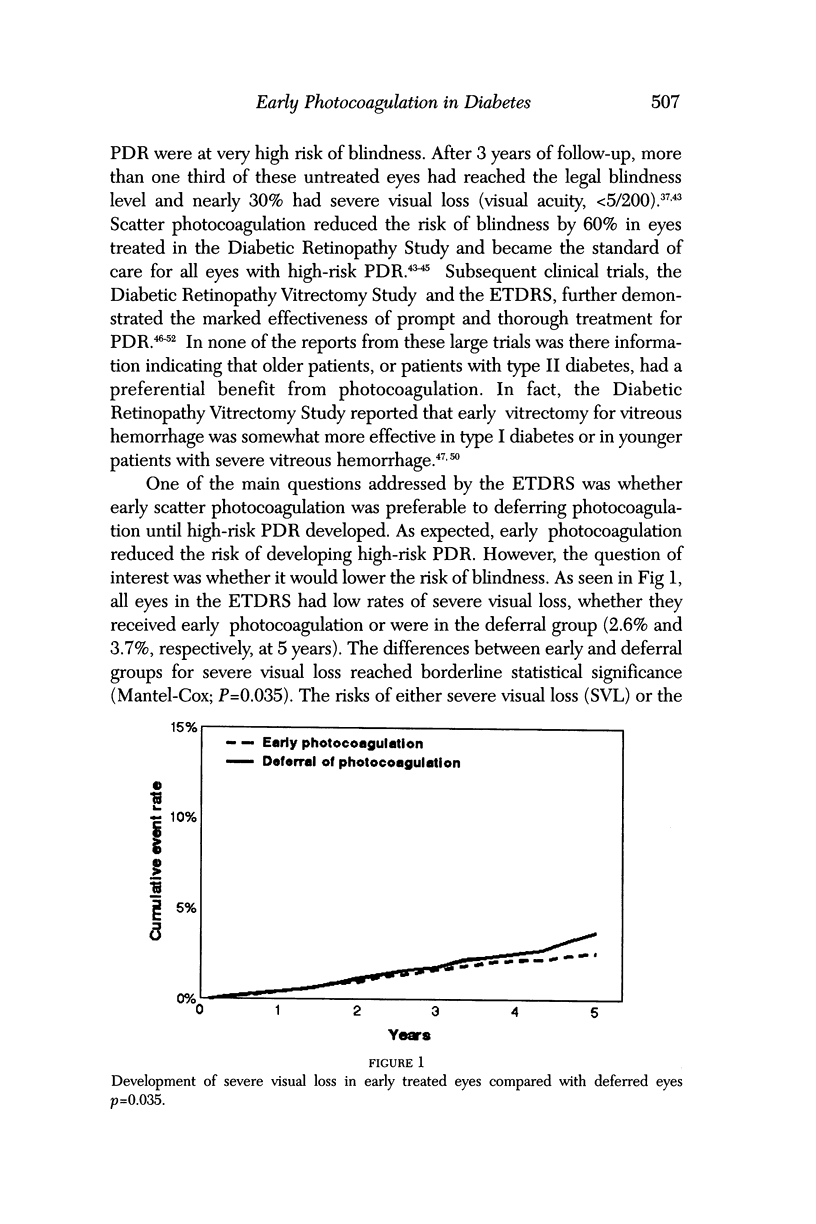
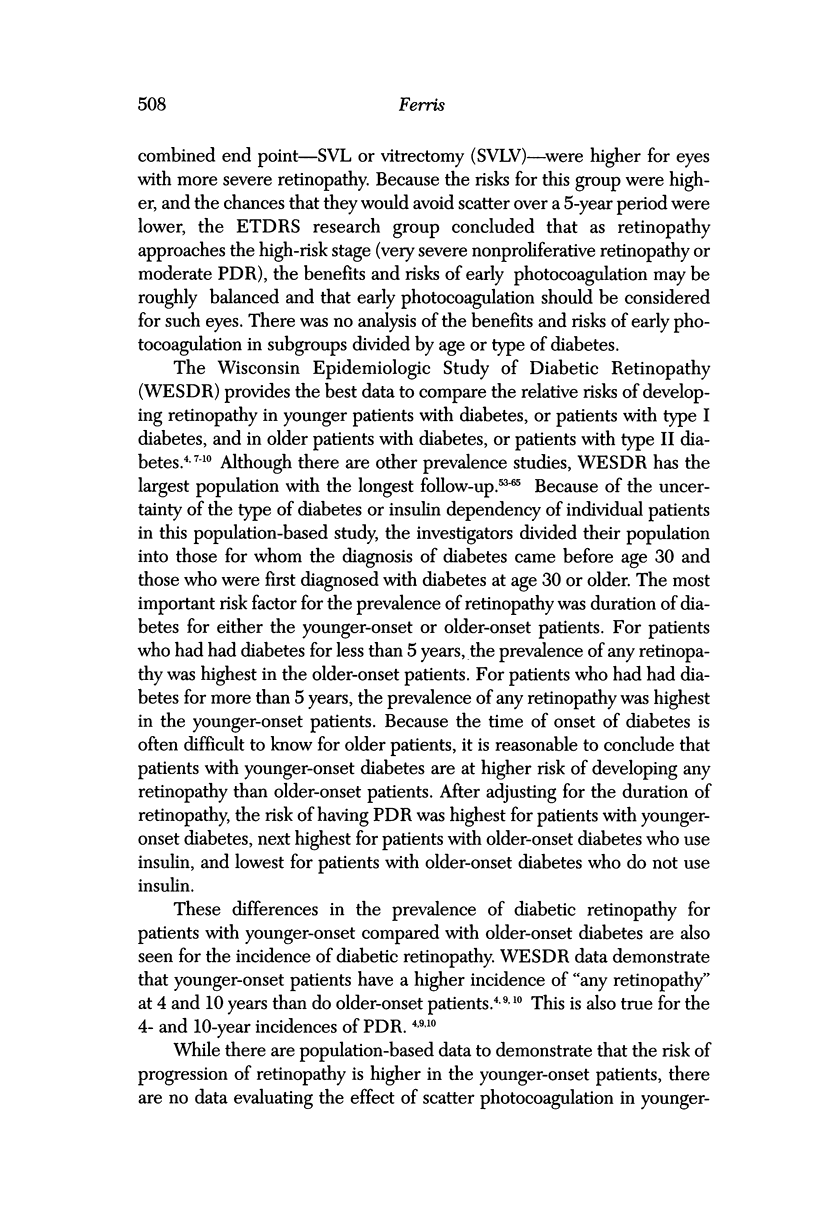
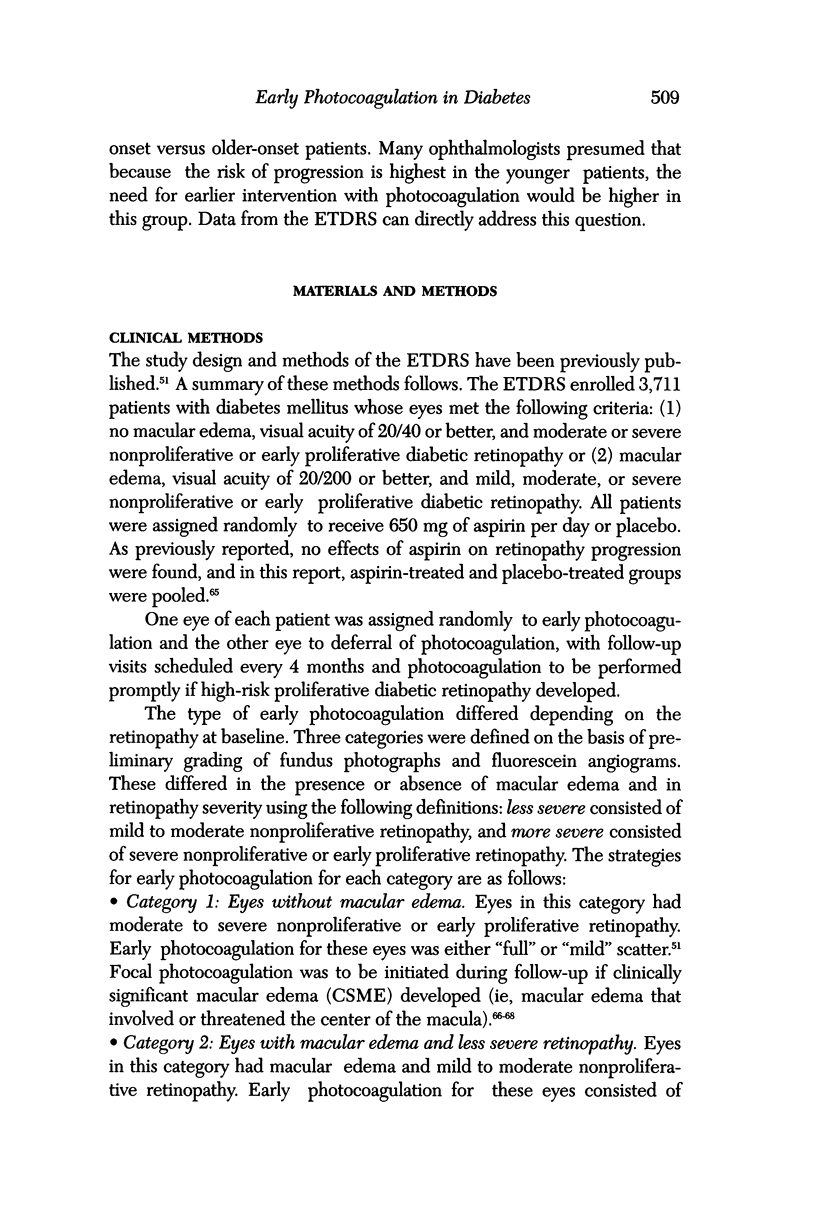
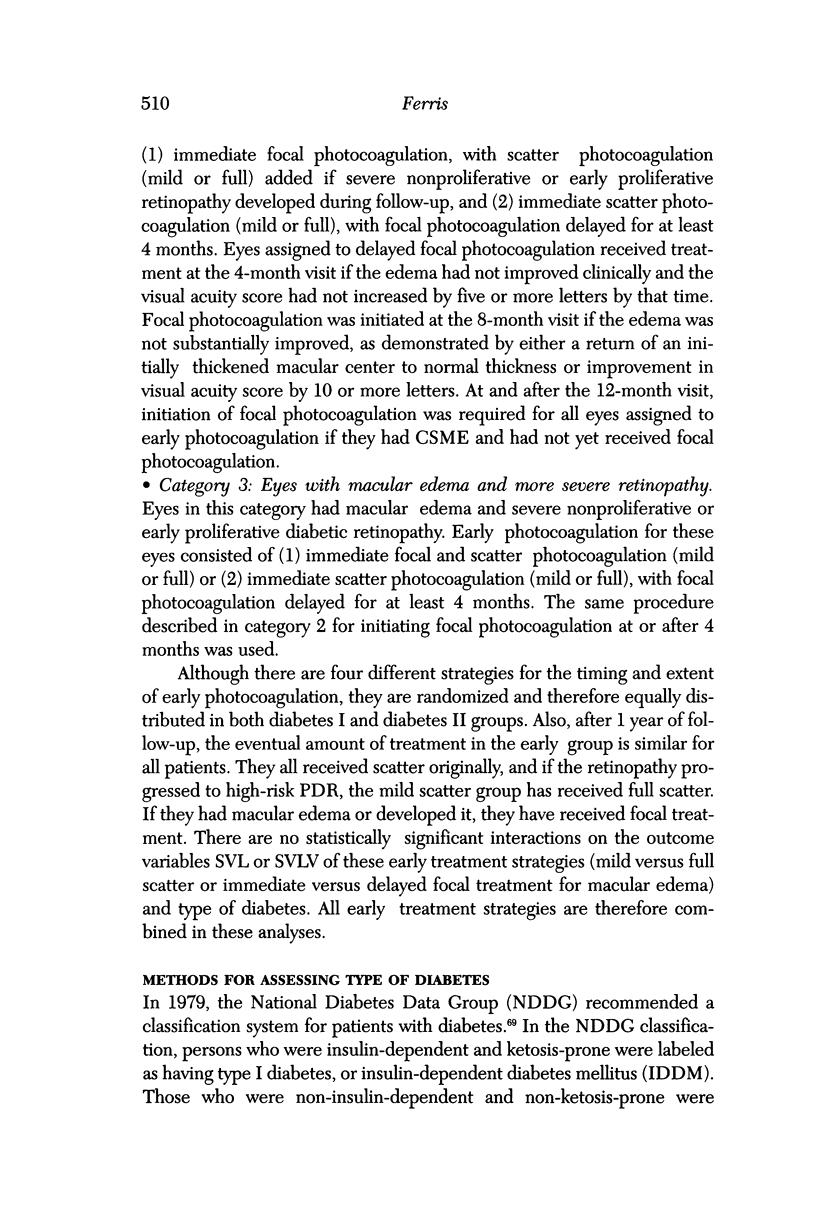
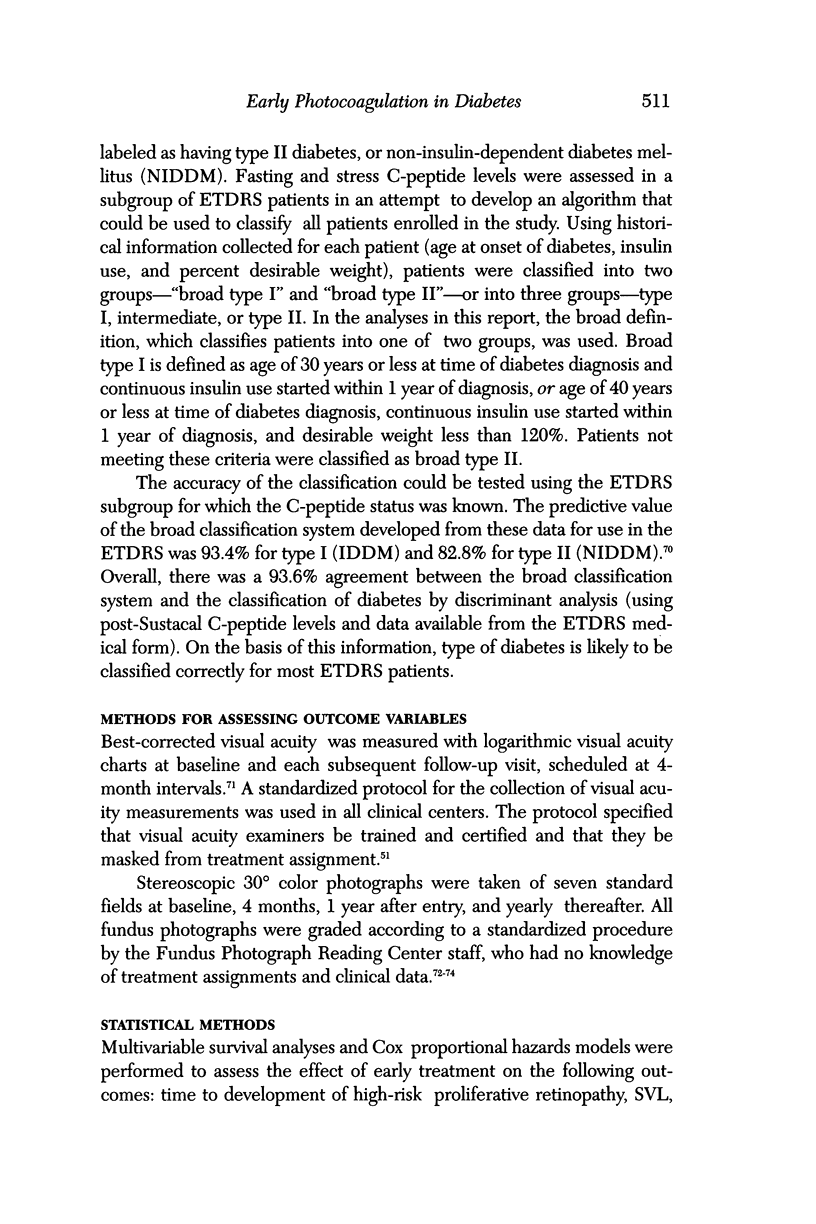
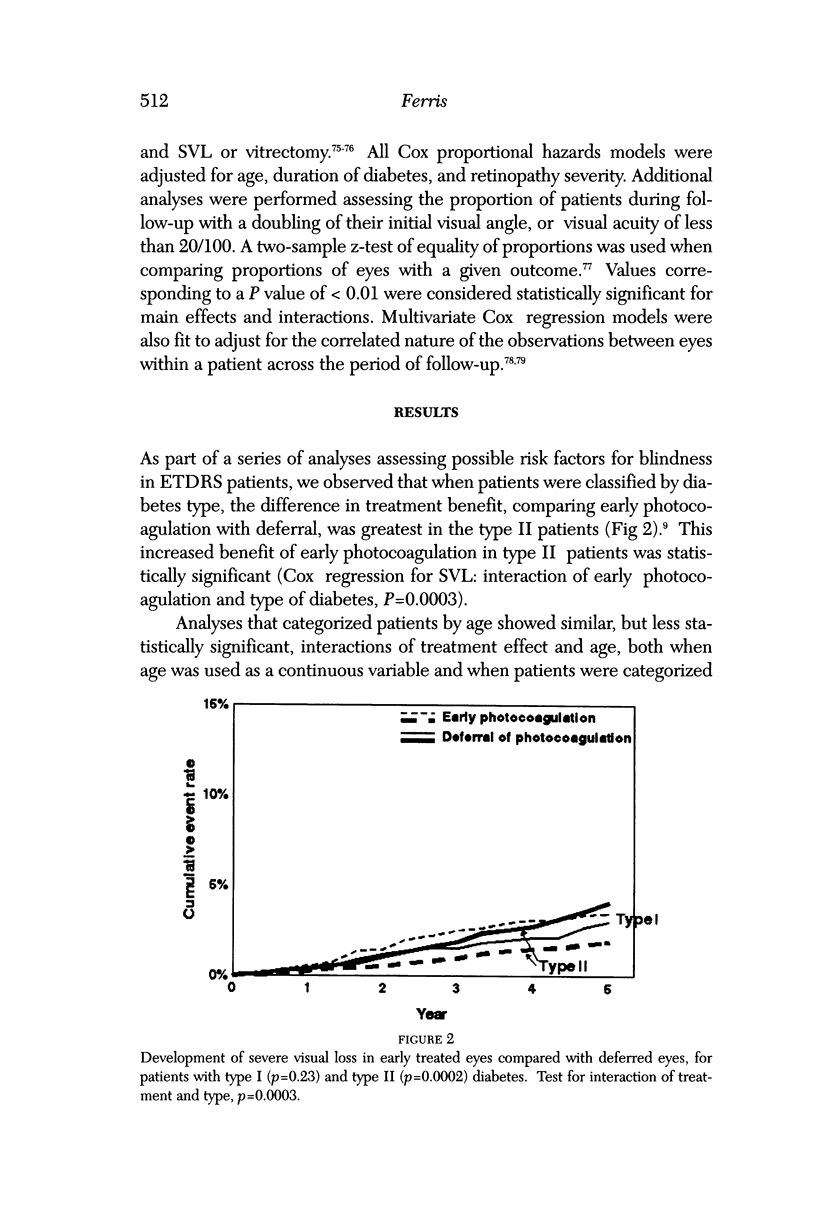
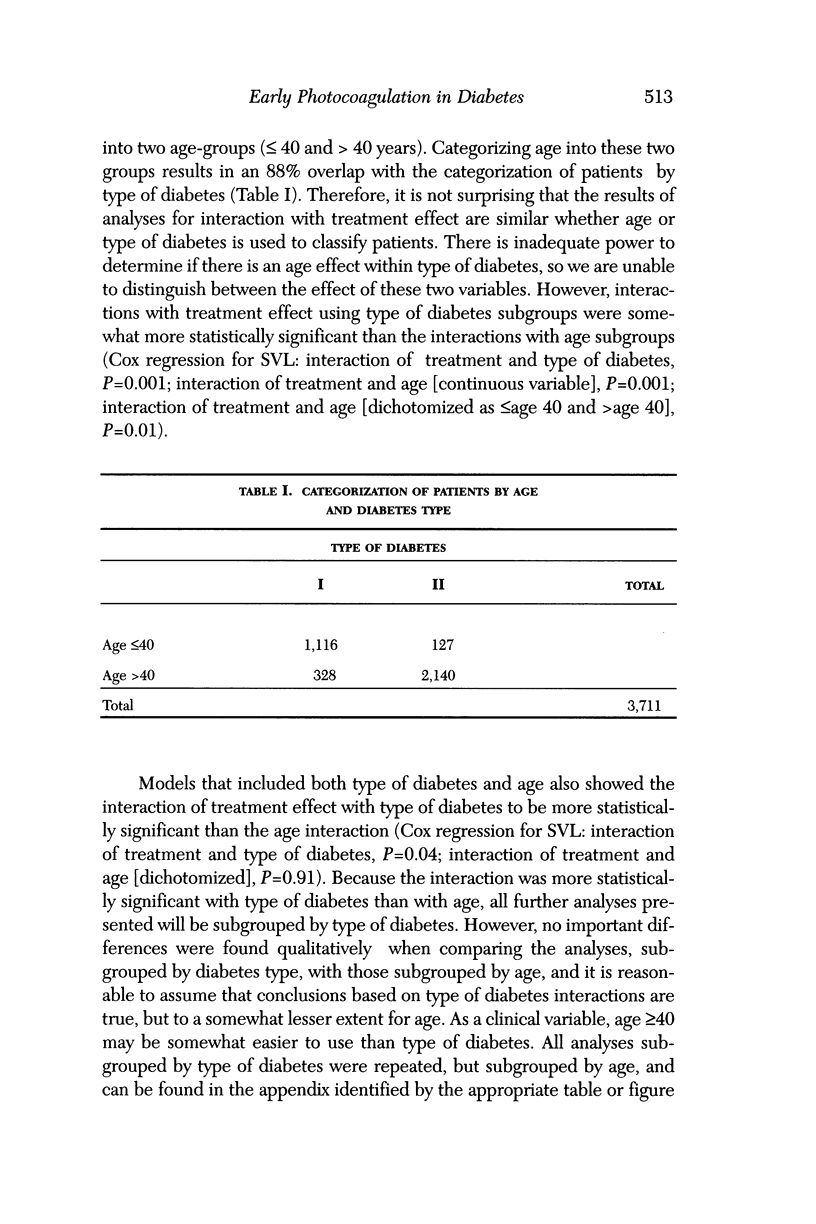
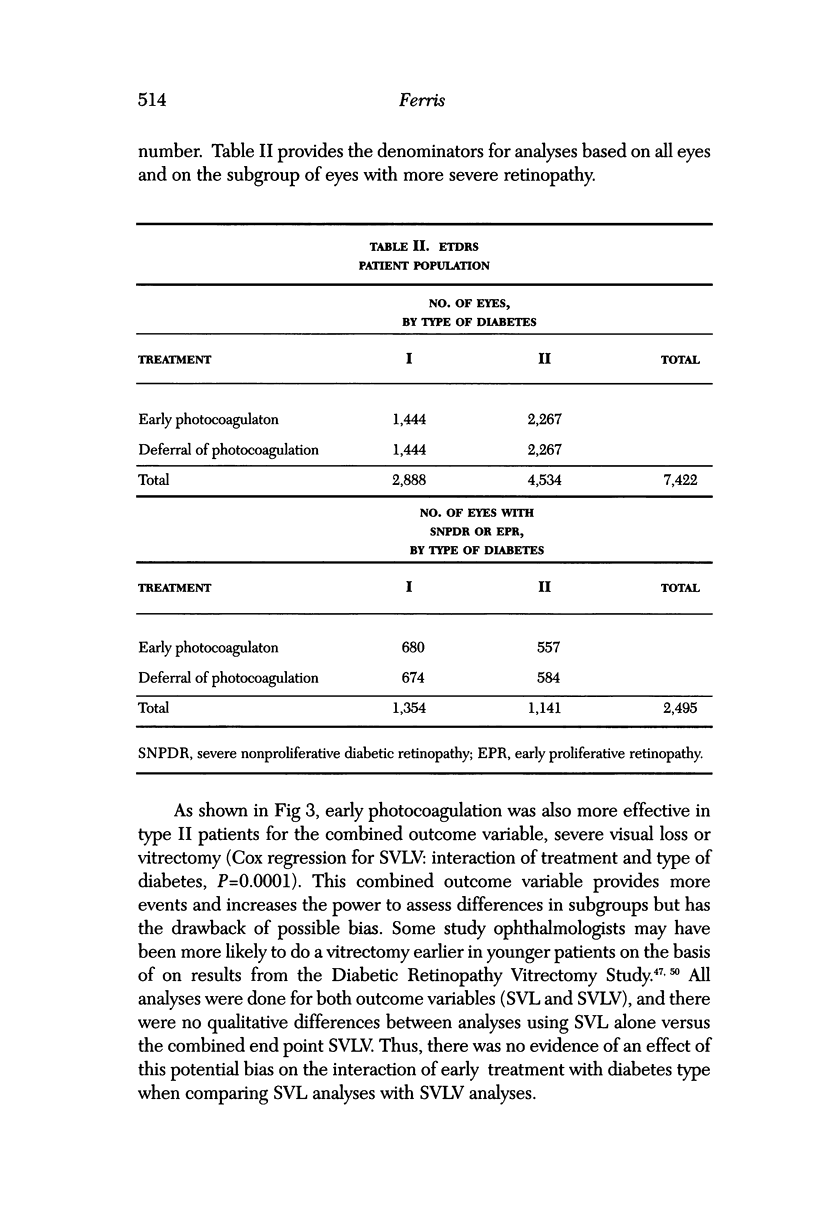
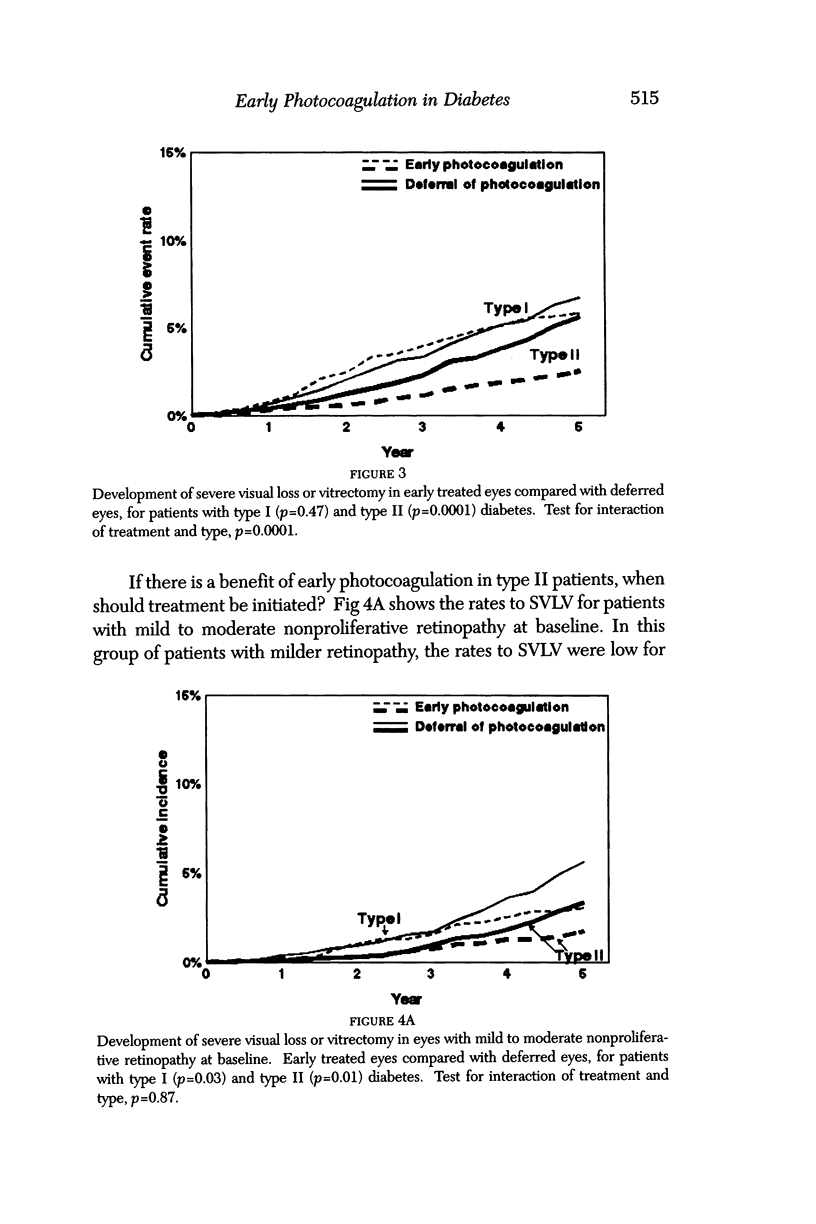
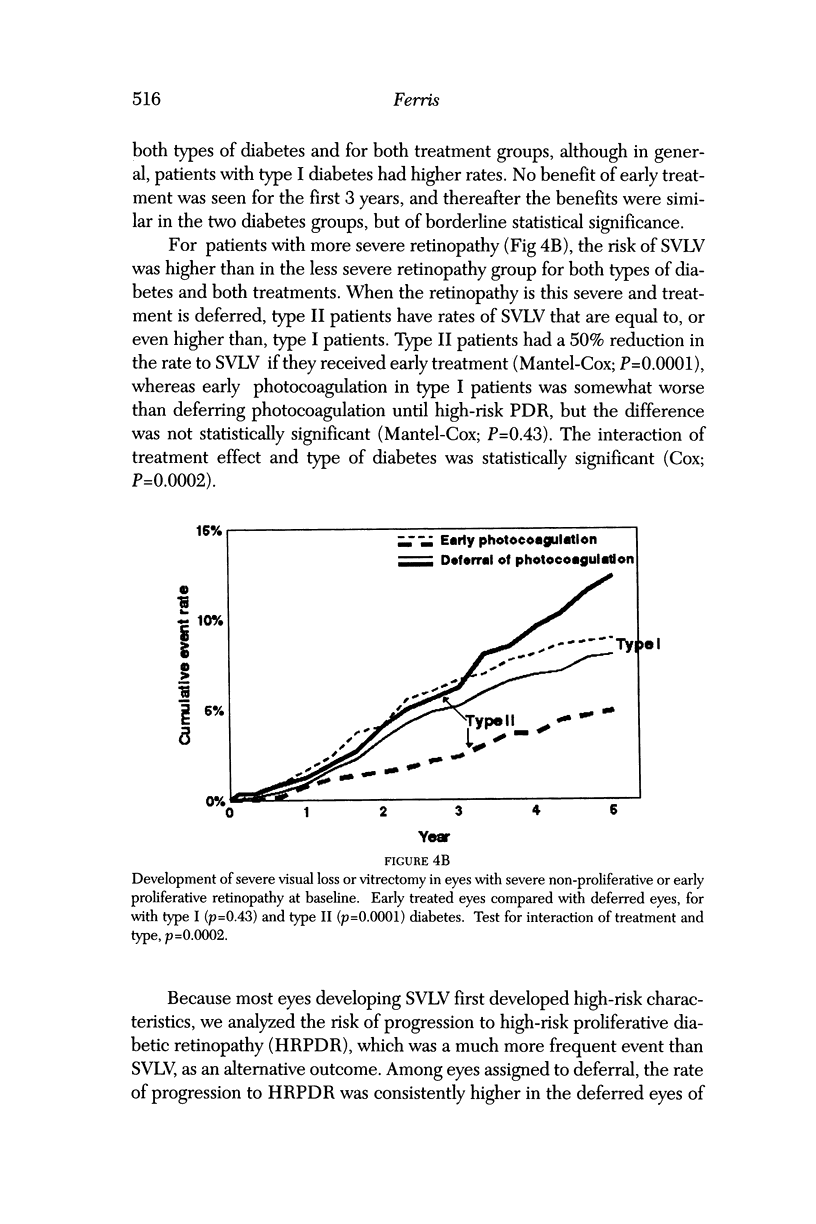
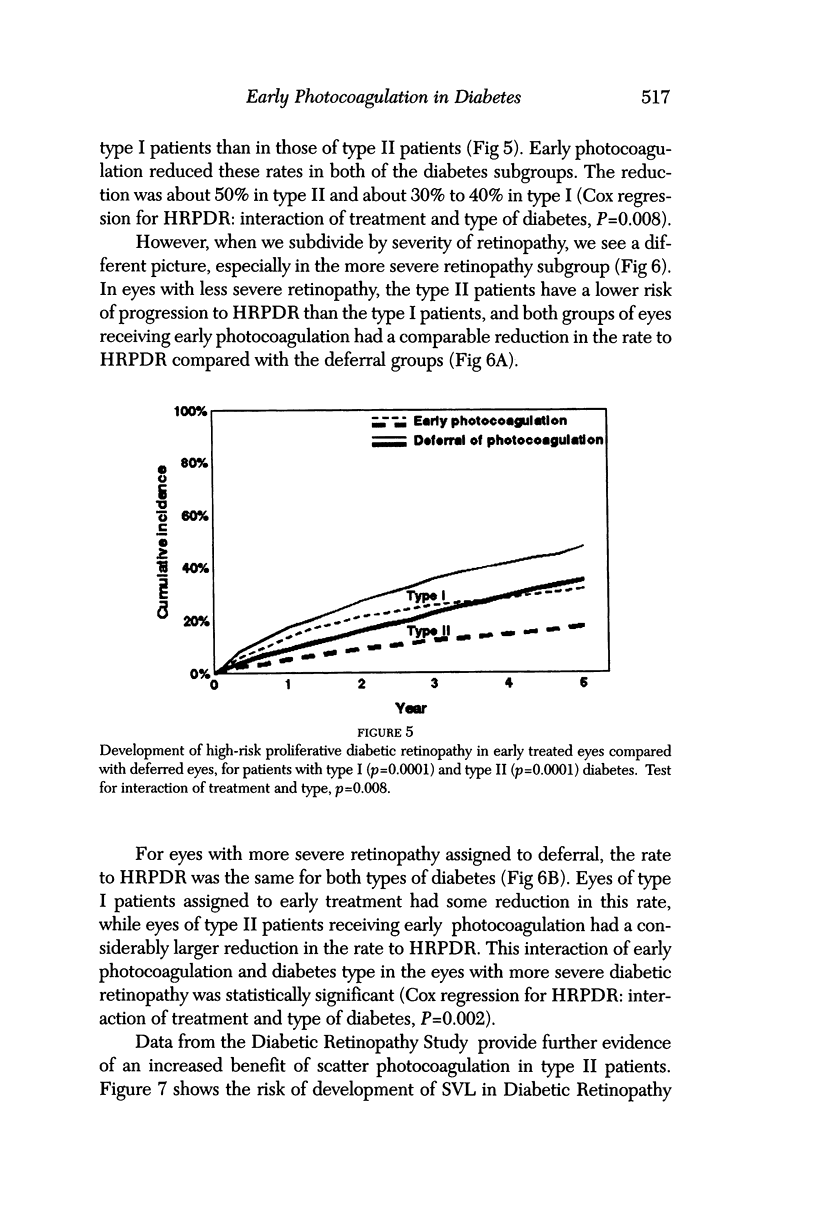
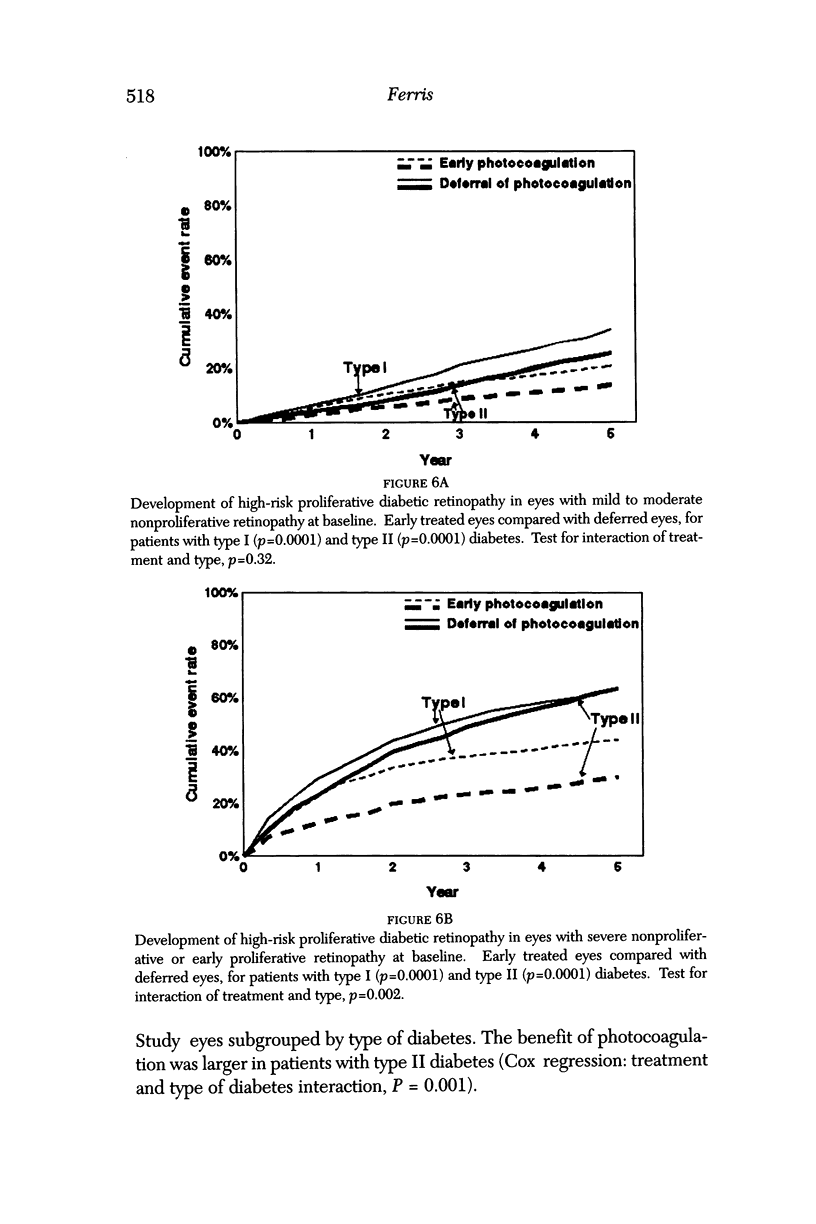
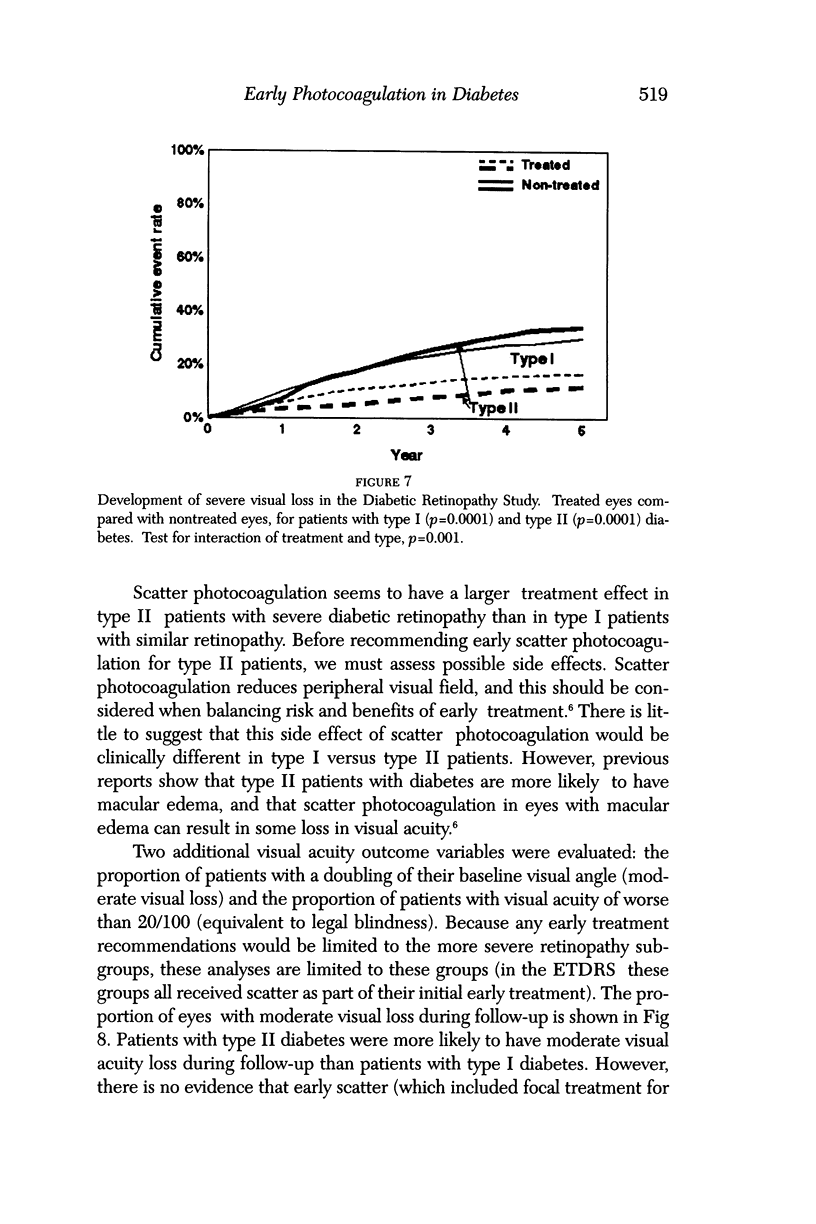
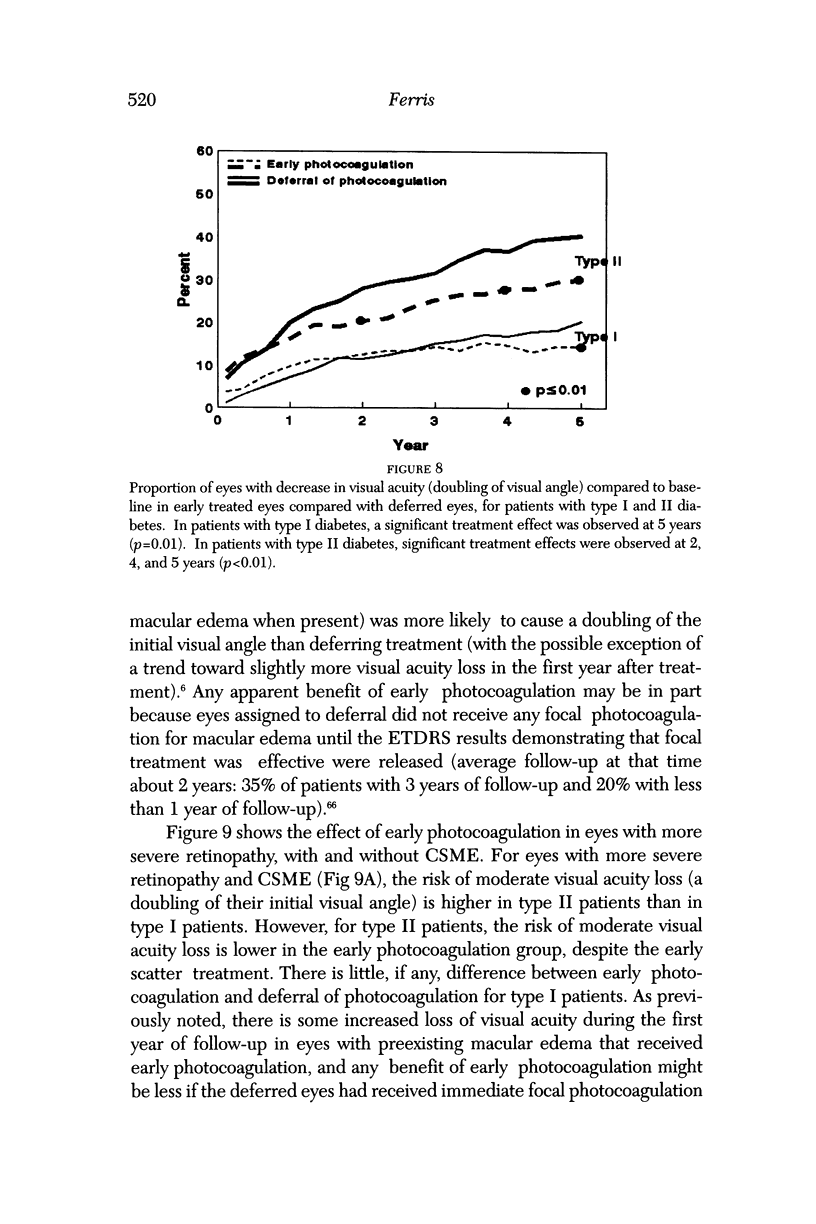
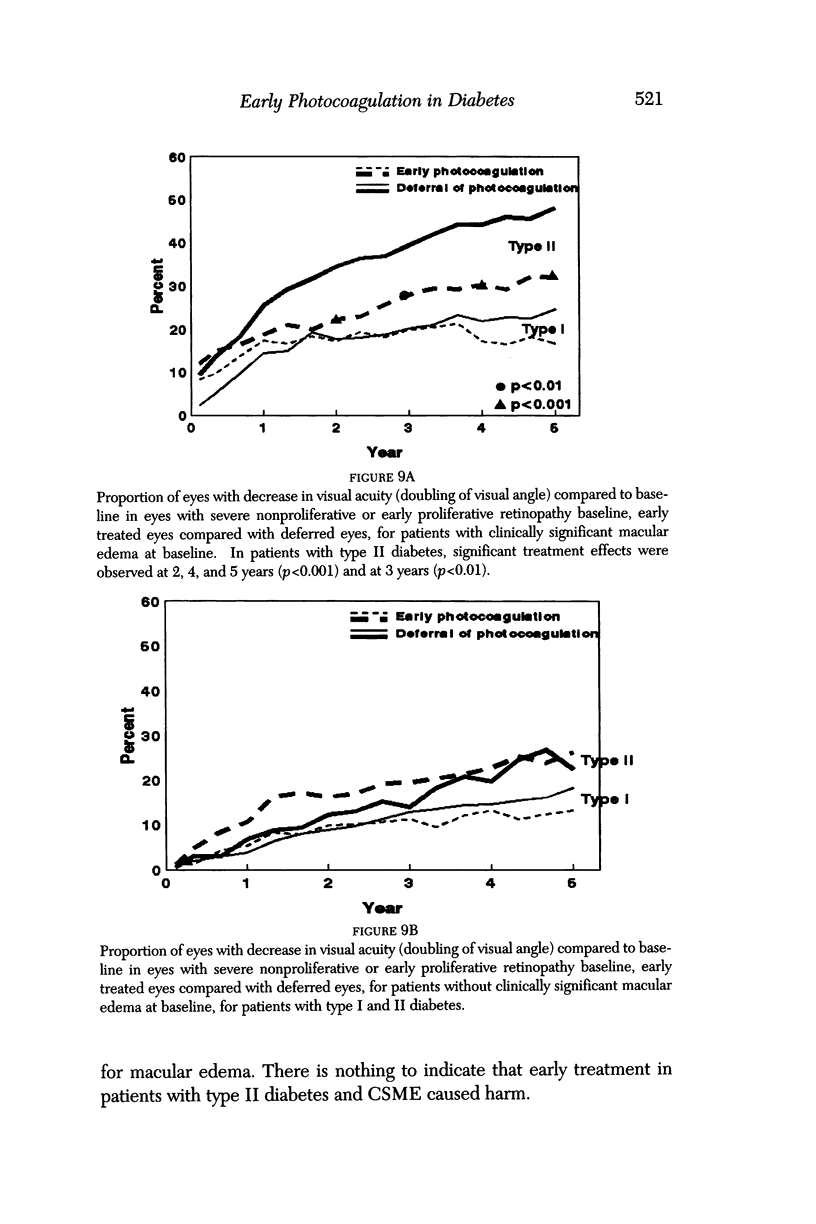
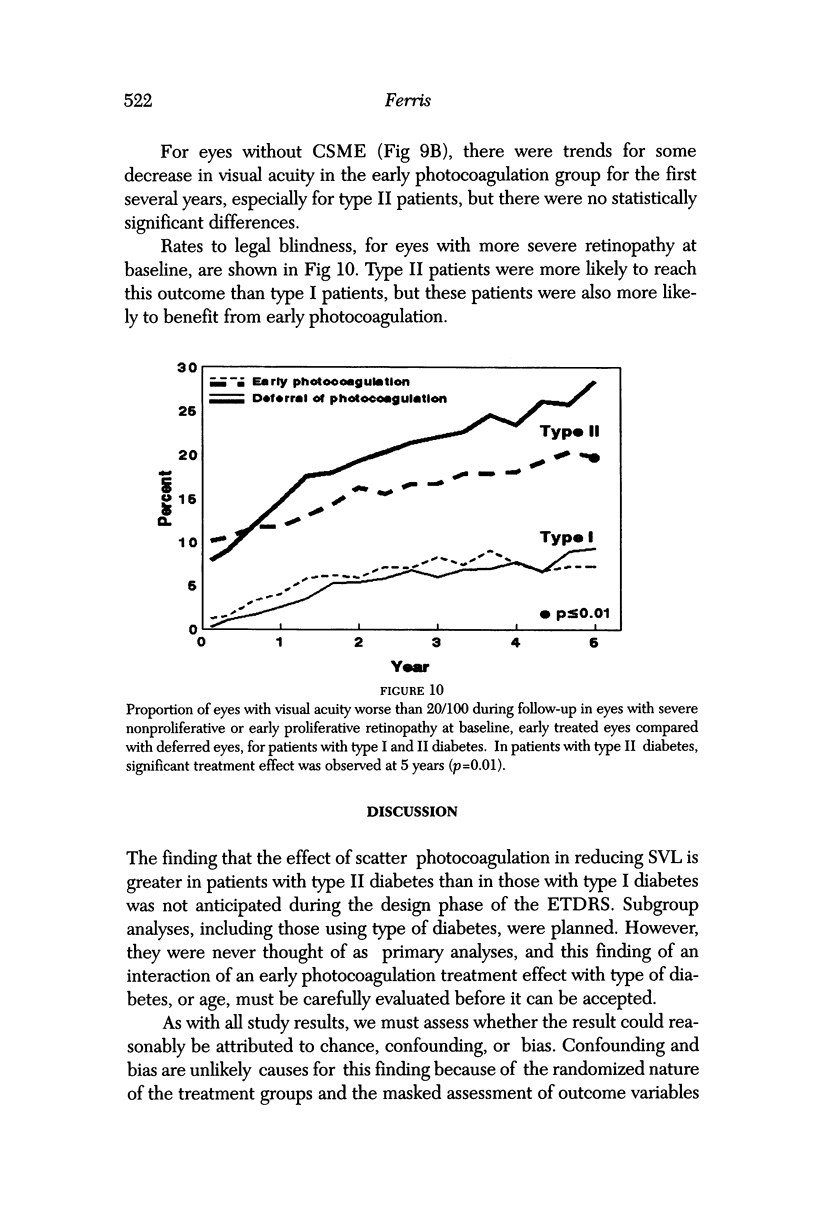
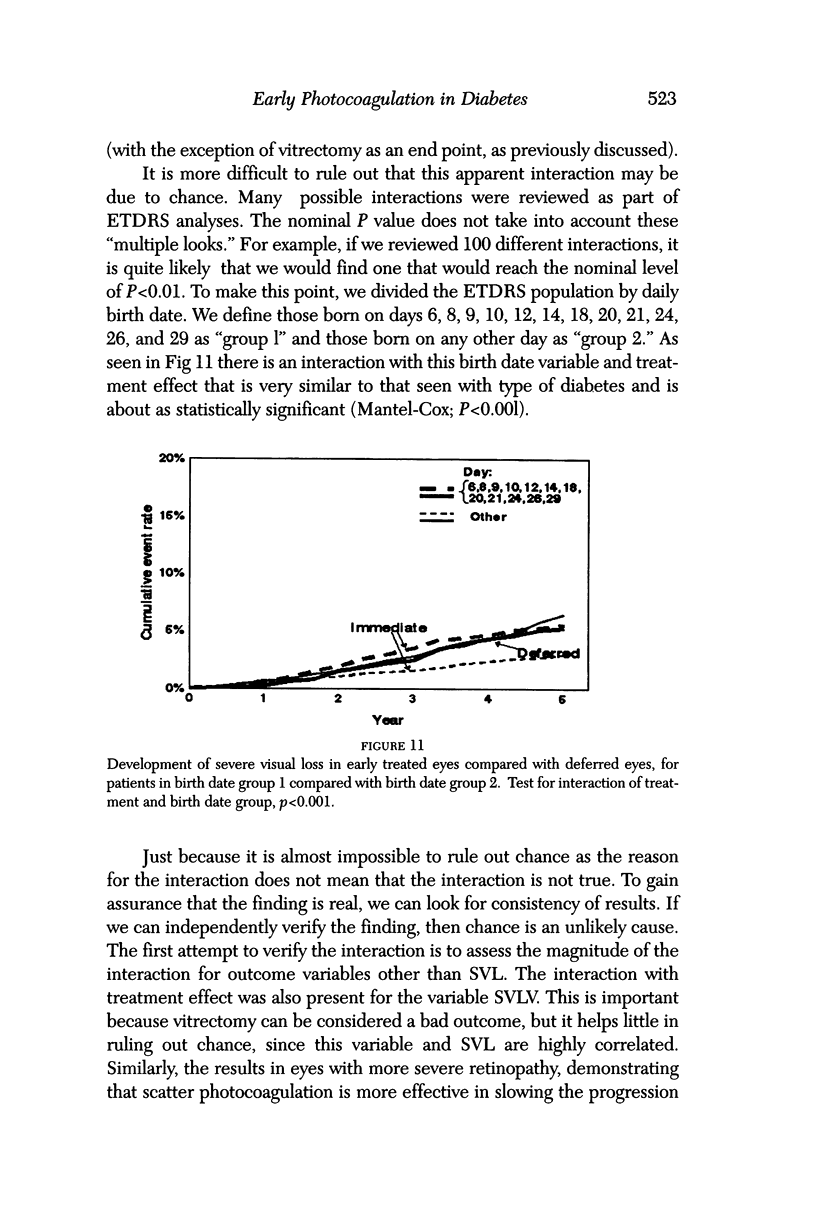
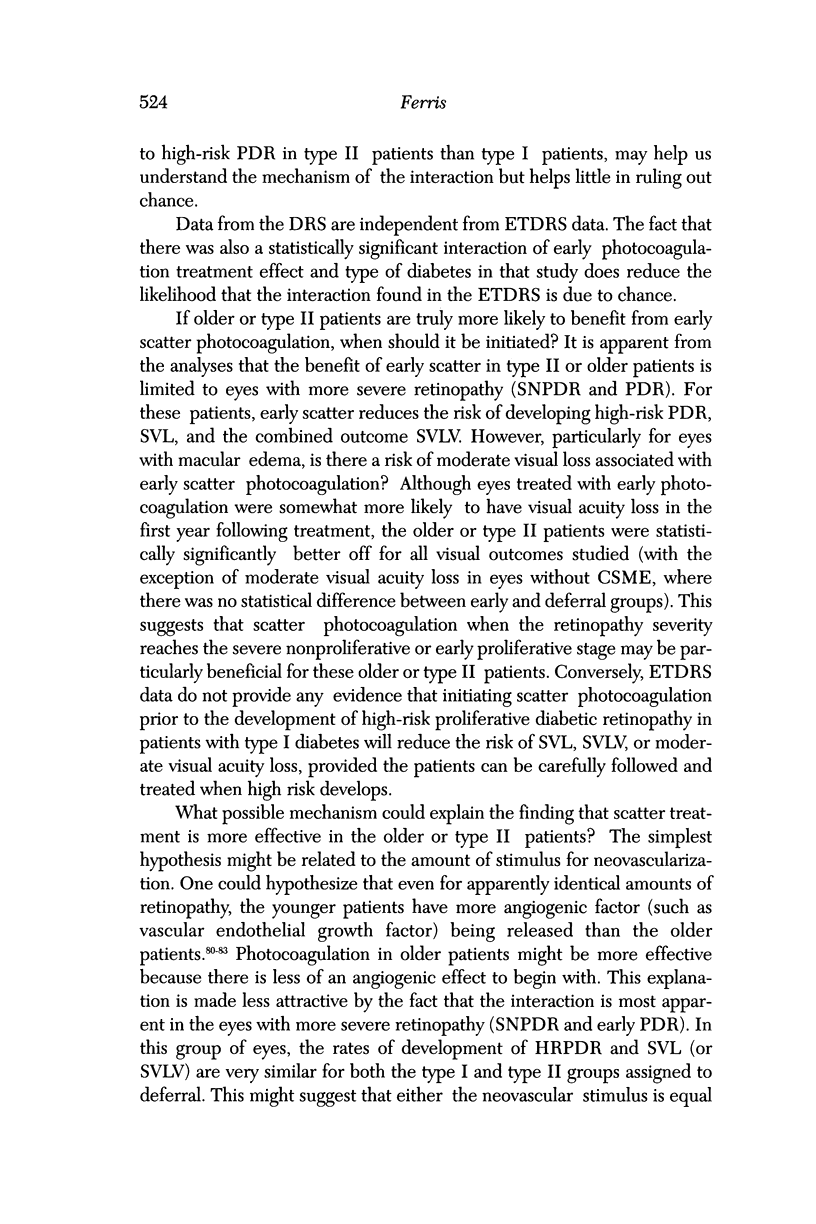
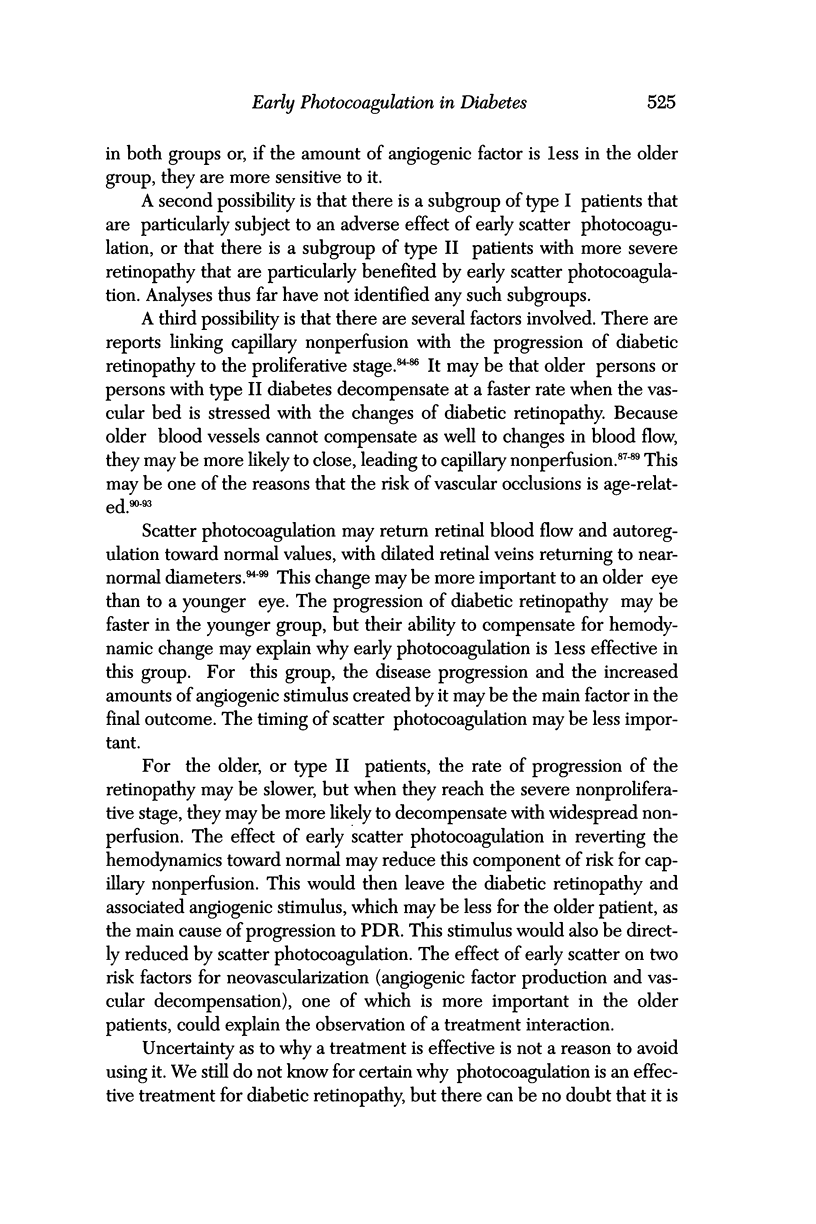
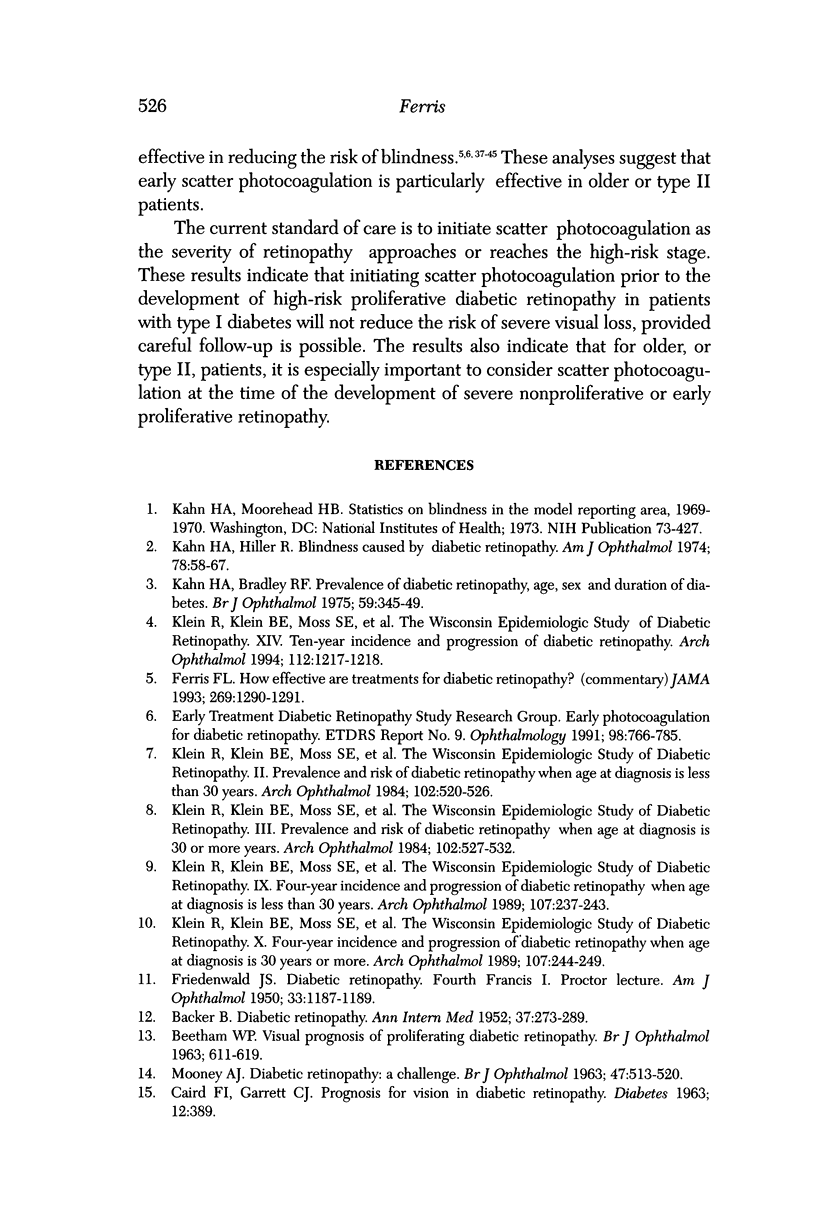
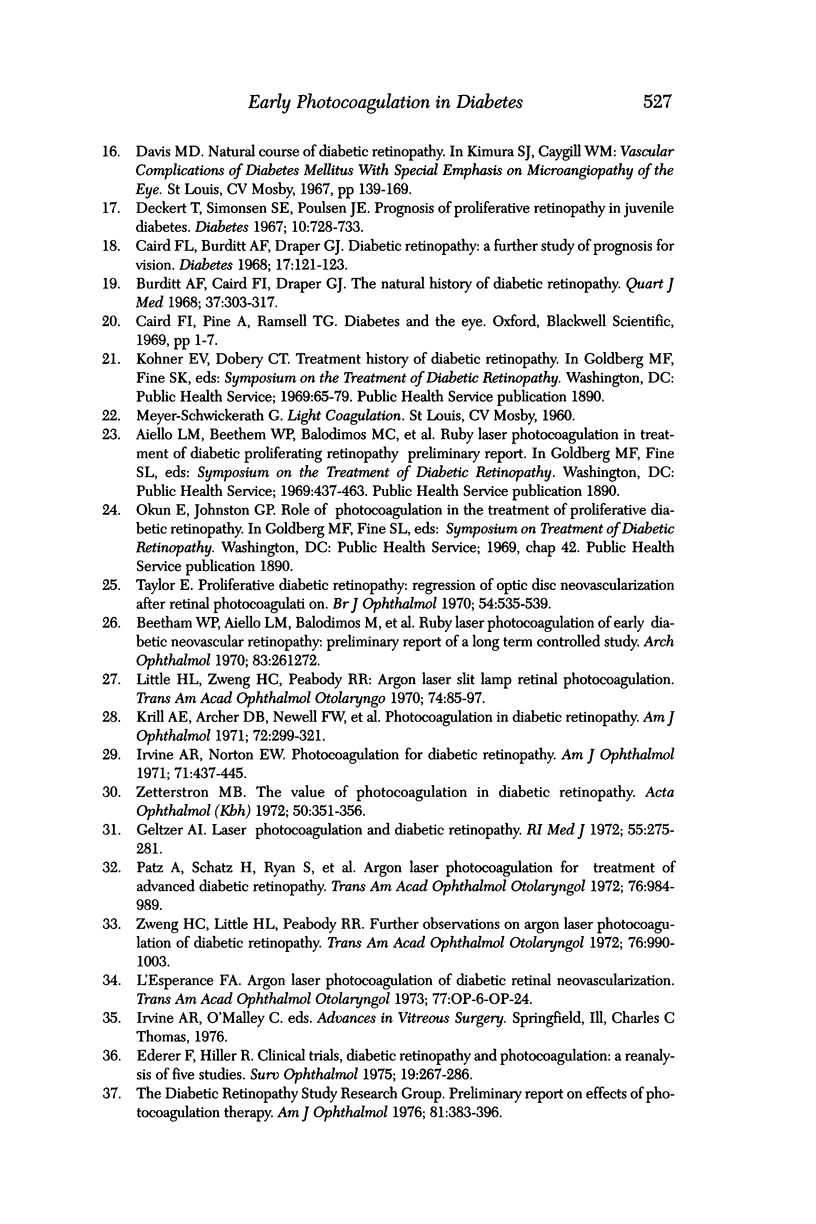
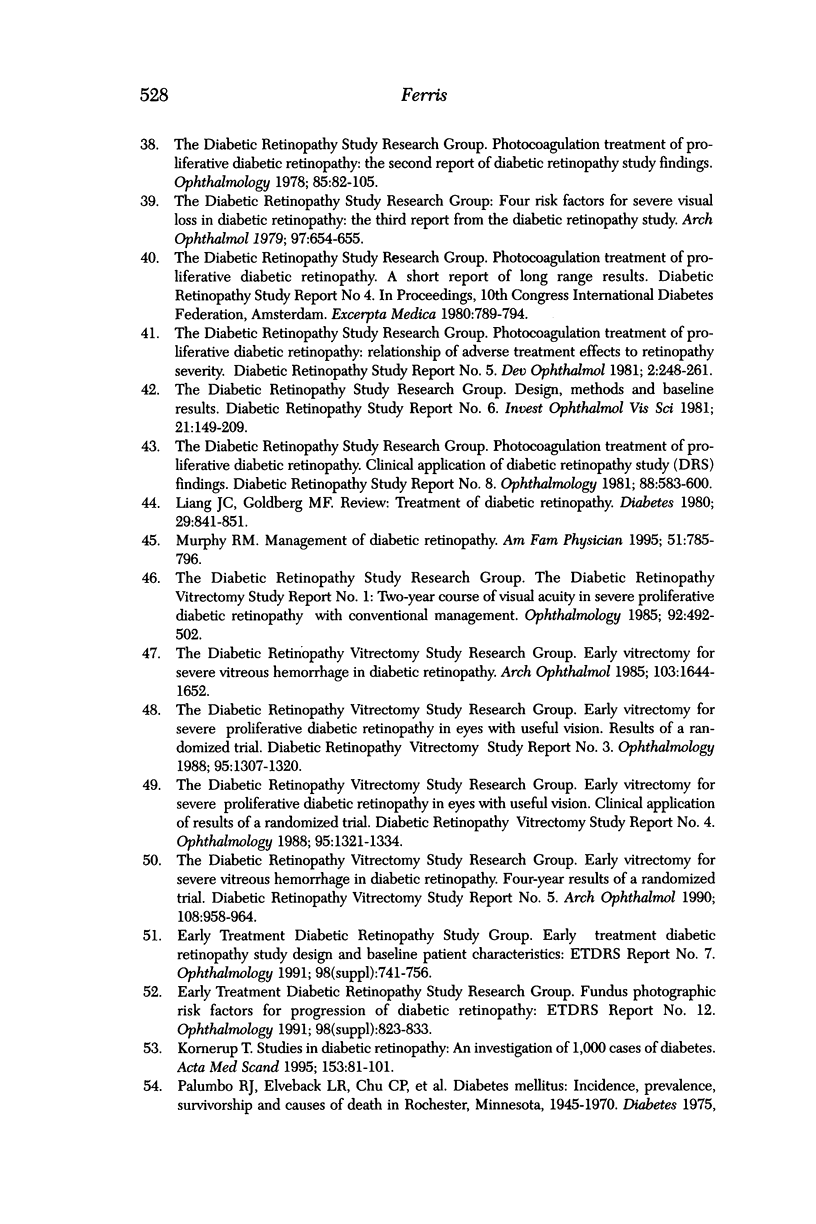
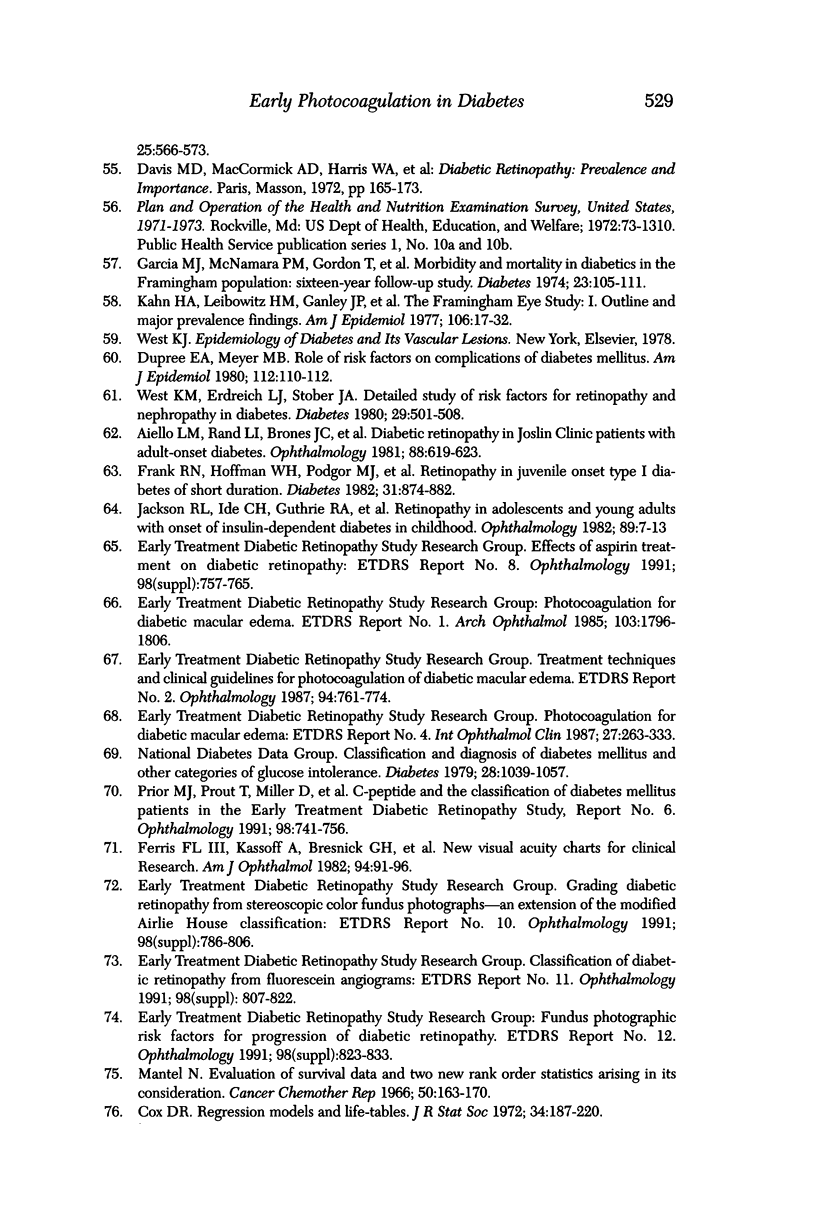
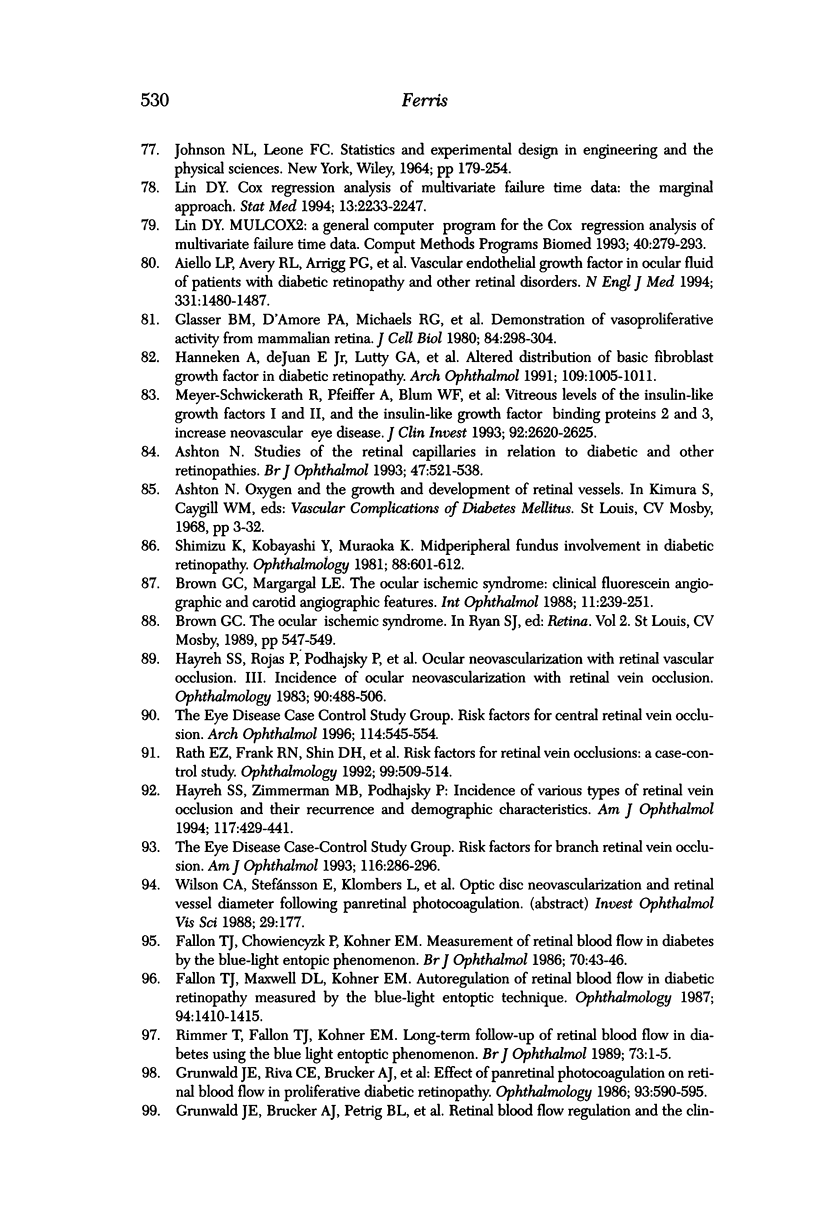
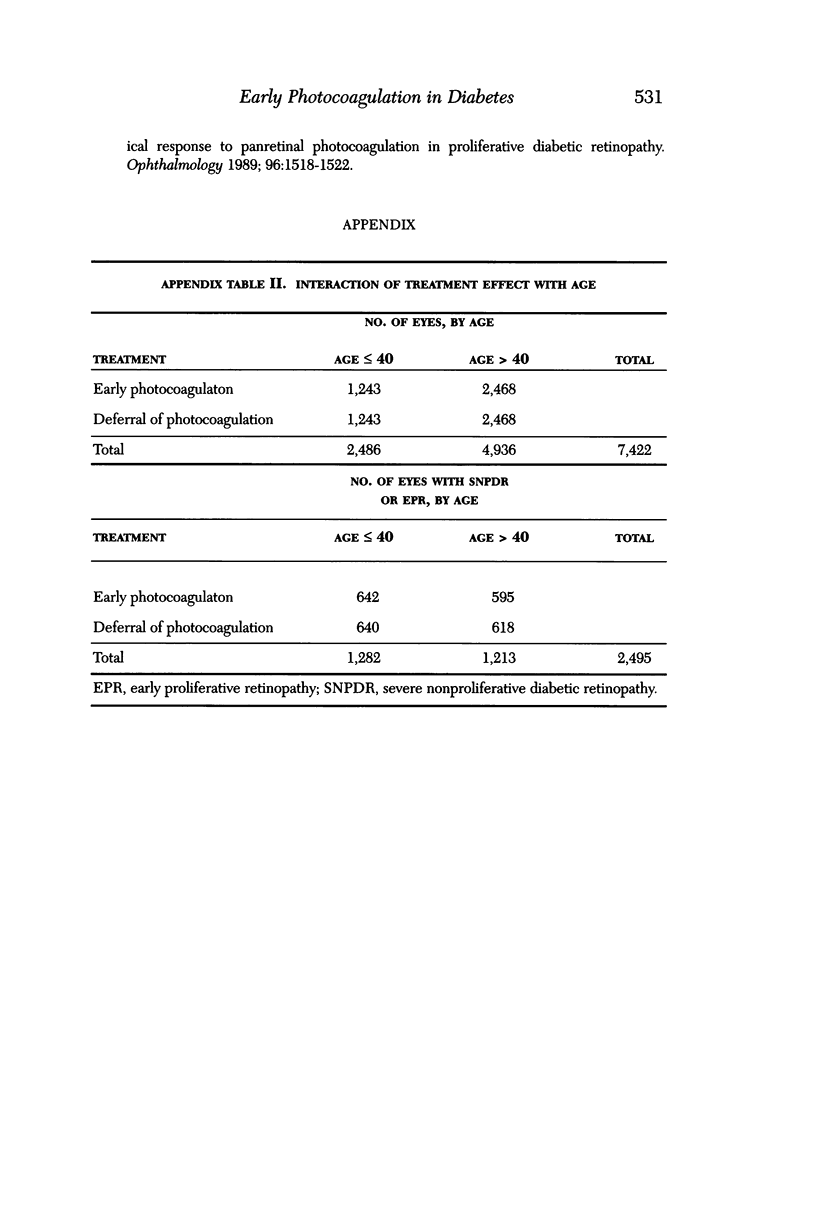
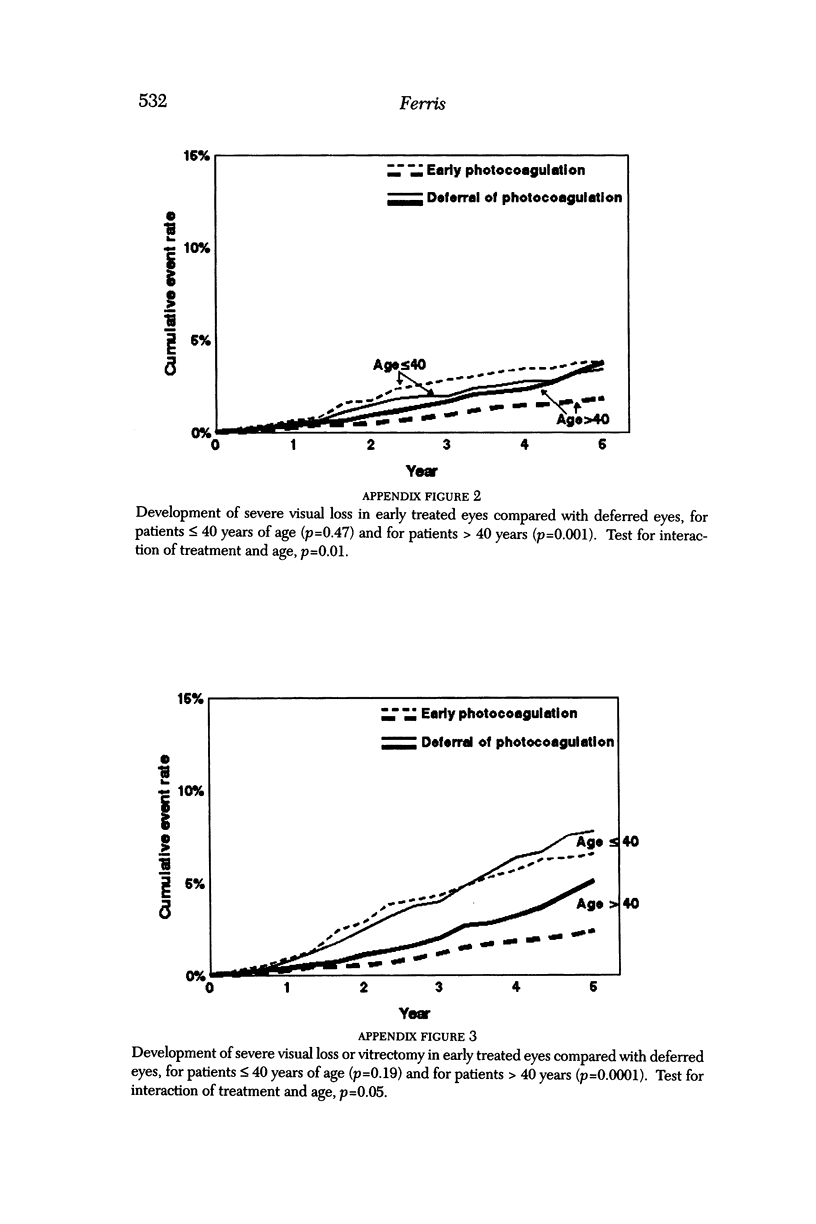
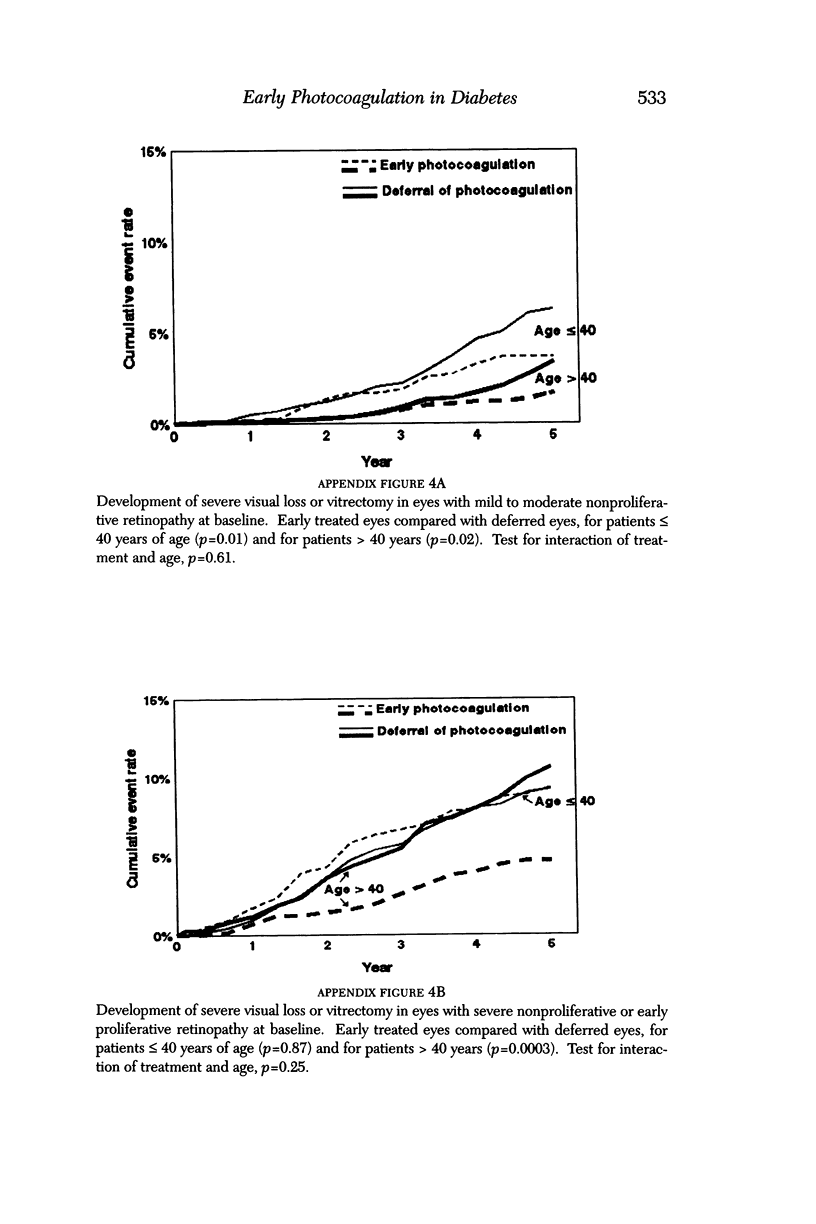
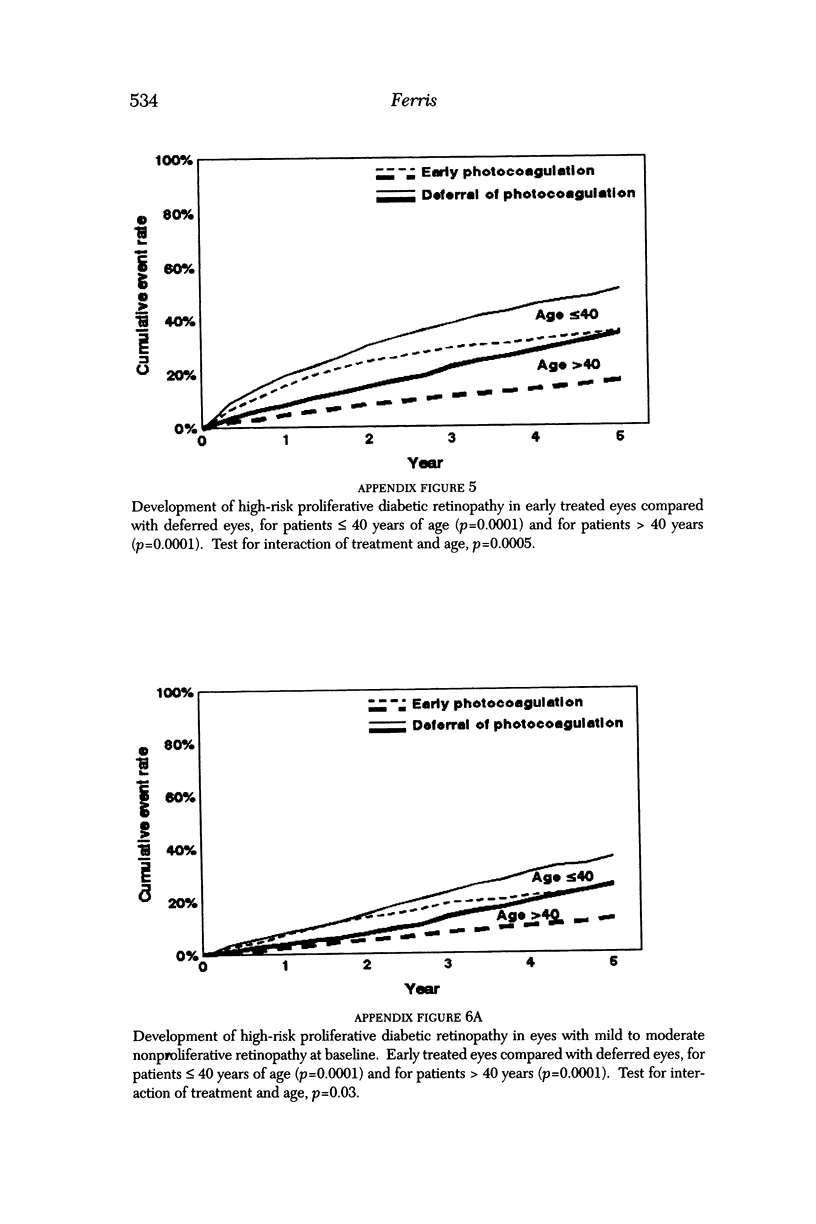
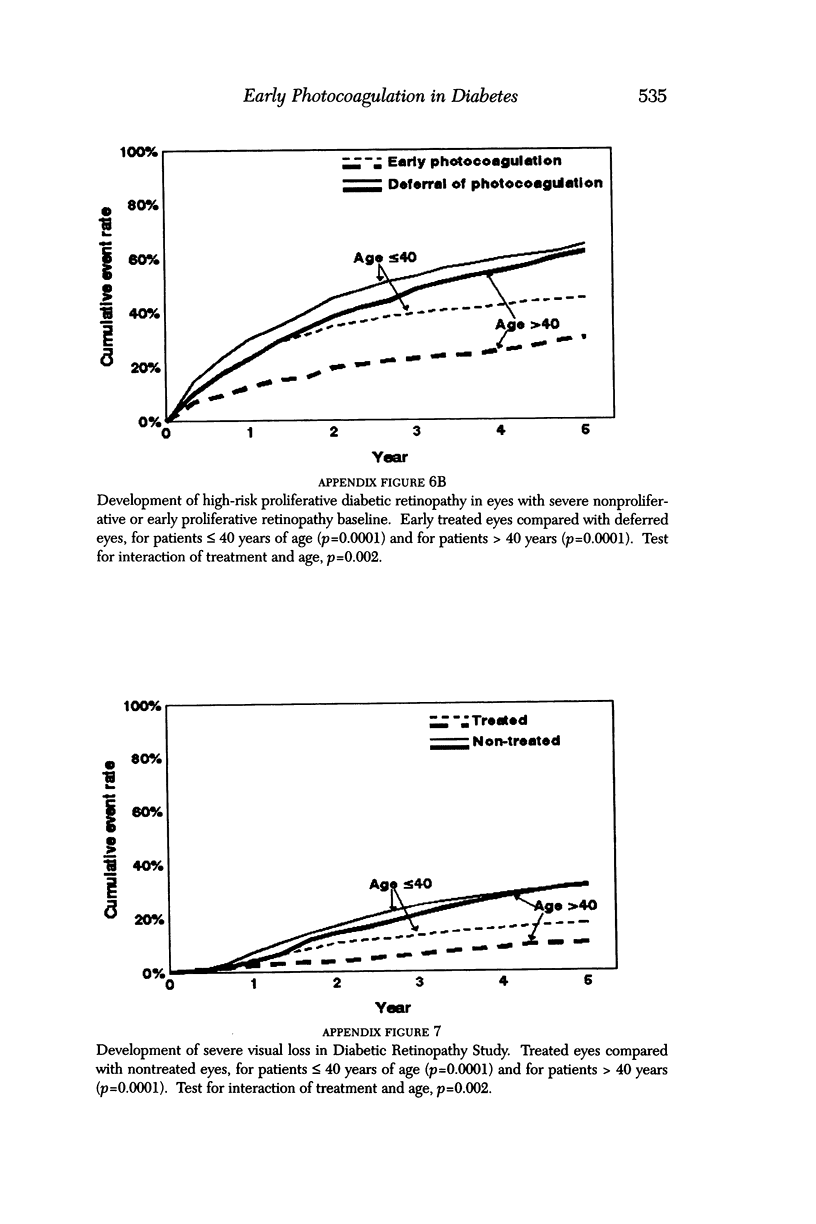
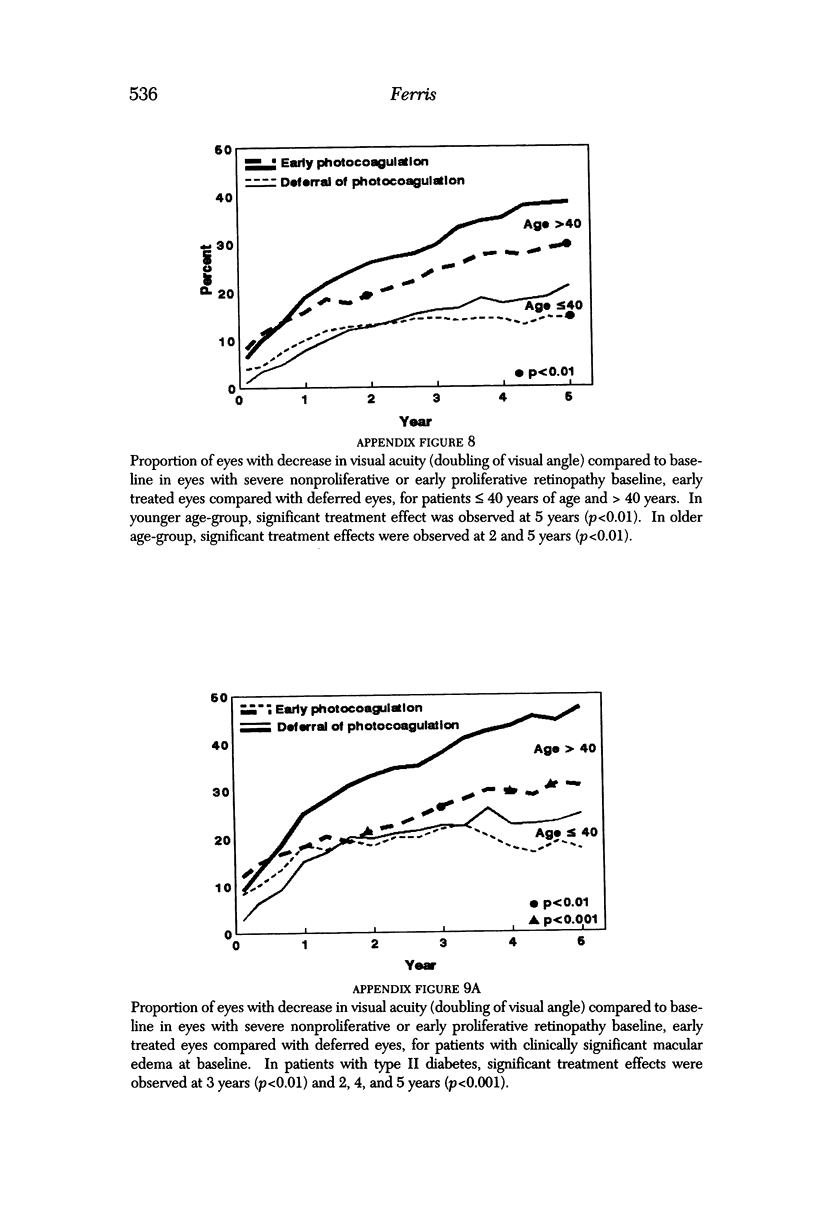
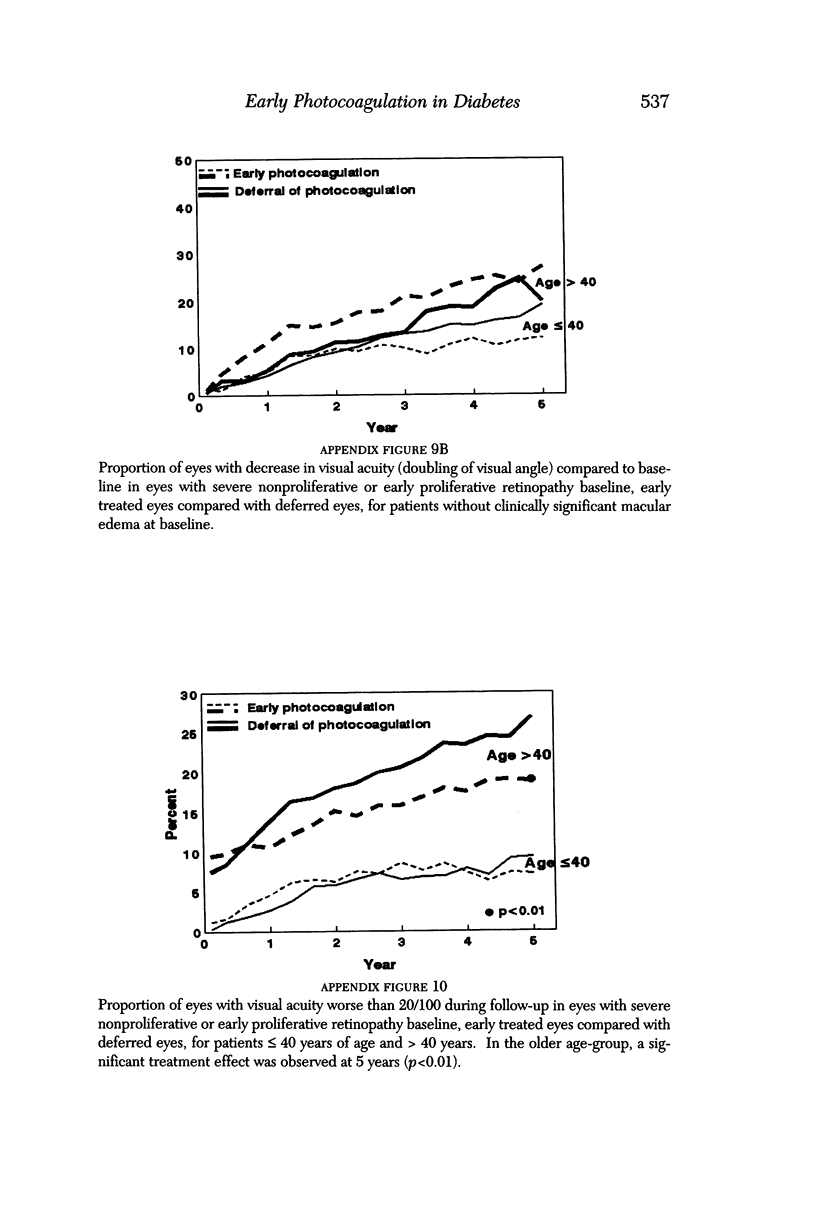
Selected References
These references are in PubMed. This may not be the complete list of references from this article.
- ASHTON N. STUDIES OF THE RETINAL CAPILLARIES IN RELATION TO DIABETIC AND OTHER RETINOPATHIES. Br J Ophthalmol. 1963 Sep;47:521–538. doi: 10.1136/bjo.47.9.521. [DOI] [PMC free article] [PubMed] [Google Scholar]
- Aiello L. M., Rand L. I., Briones J. C., Wafai M. Z., Sebestyen J. G. Diabetic retinopathy in Joslin Clinic patients with adult-onset diabetes. Ophthalmology. 1981 Jul;88(7):619–623. doi: 10.1016/s0161-6420(81)34982-3. [DOI] [PubMed] [Google Scholar]
- Aiello L. P., Avery R. L., Arrigg P. G., Keyt B. A., Jampel H. D., Shah S. T., Pasquale L. R., Thieme H., Iwamoto M. A., Park J. E. Vascular endothelial growth factor in ocular fluid of patients with diabetic retinopathy and other retinal disorders. N Engl J Med. 1994 Dec 1;331(22):1480–1487. doi: 10.1056/NEJM199412013312203. [DOI] [PubMed] [Google Scholar]
- BECKER B. Diabetic retinopathy. Ann Intern Med. 1952 Aug;37(2):273–289. doi: 10.7326/0003-4819-37-2-273. [DOI] [PubMed] [Google Scholar]
- BEETHAM W. P. VISUAL PROGNOSIS OF PROLIFERATING DIABETIC RETINOPATHY. Br J Ophthalmol. 1963 Oct;47:611–619. doi: 10.1136/bjo.47.10.611. [DOI] [PMC free article] [PubMed] [Google Scholar]
- Beetham W. P., Aiello L. M., Balodimos M. C., Koncz L. Ruby laser photocoagulation of early diabetic neovascular retinopathy. Preliminary report of a long-term controlled study. Arch Ophthalmol. 1970 Mar;83(3):261–272. doi: 10.1001/archopht.1970.00990030263001. [DOI] [PubMed] [Google Scholar]
- Brown G. C., Magargal L. E. The ocular ischemic syndrome. Clinical, fluorescein angiographic and carotid angiographic features. Int Ophthalmol. 1988 Feb;11(4):239–251. doi: 10.1007/BF00131023. [DOI] [PubMed] [Google Scholar]
- Burditt A. G., Caird F. I., Draper G. J. The natural history of diabetic retinopathy. Q J Med. 1968 Apr;37(146):303–317. [PubMed] [Google Scholar]
- CAIRD F. I., GARRETT C. J. PROGNOSIS FOR VISION IN DIABETIC RETINOPATHY. Diabetes. 1963 Sep-Oct;12:389–397. doi: 10.2337/diab.12.5.389. [DOI] [PubMed] [Google Scholar]
- Caird F. I., Burditt A. F., Draper G. J. Diabetic retinopathy. A further study of prognosis for vision. Diabetes. 1968 Mar;17(3):121–123. doi: 10.2337/diab.17.3.121. [DOI] [PubMed] [Google Scholar]
- Deckert T., Simonsen S. E., Poulsen J. E. Prognosis of proliferative retinopathy in juvenile diabetics. Diabetes. 1967 Oct;16(10):728–733. doi: 10.2337/diab.16.10.728. [DOI] [PubMed] [Google Scholar]
- Dupree E. A., Meyer M. B. Role of risk factors in complications of diabetes mellitus. Am J Epidemiol. 1980 Jul;112(1):100–112. doi: 10.1093/oxfordjournals.aje.a112959. [DOI] [PubMed] [Google Scholar]
- Early Treatment Diabetic Retinopathy Study design and baseline patient characteristics. ETDRS report number 7. Ophthalmology. 1991 May;98(5 Suppl):741–756. doi: 10.1016/s0161-6420(13)38009-9. [DOI] [PubMed] [Google Scholar]
- Ederer F., Hiller R. Clinical trials, diabetic retinopathy and photocoagulation. A reanalysis of five studies. Surv Ophthalmol. 1975 Mar-Apr;19(5):267–286. [PubMed] [Google Scholar]
- FRIEDENWALD J. S. Diabetic retinopathy. Am J Ophthalmol. 1950 Aug;33(8):1187–1199. doi: 10.1016/0002-9394(50)90988-3. [DOI] [PubMed] [Google Scholar]
- Fallon T. J., Chowiencyzk P., Kohner E. M. Measurement of retinal blood flow in diabetes by the blue-light entoptic phenomenon. Br J Ophthalmol. 1986 Jan;70(1):43–46. doi: 10.1136/bjo.70.1.43. [DOI] [PMC free article] [PubMed] [Google Scholar]
- Fallon T. J., Maxwell D. L., Kohner E. M. Autoregulation of retinal blood flow in diabetic retinopathy measured by the blue-light entoptic technique. Ophthalmology. 1987 Nov;94(11):1410–1415. doi: 10.1016/s0161-6420(87)33271-3. [DOI] [PubMed] [Google Scholar]
- Ferris F. L., 3rd How effective are treatments for diabetic retinopathy? JAMA. 1993 Mar 10;269(10):1290–1291. [PubMed] [Google Scholar]
- Ferris F. L., 3rd, Kassoff A., Bresnick G. H., Bailey I. New visual acuity charts for clinical research. Am J Ophthalmol. 1982 Jul;94(1):91–96. [PubMed] [Google Scholar]
- Frank R. N., Hoffman W. H., Podgor M. J., Joondeph H. C., Lewis R. A., Margherio R. R., Nachazel D. P., Jr, Weiss H., Christopherson K. W., Cronin M. A. Retinopathy in juvenile-onset type I diabetes of short duration. Diabetes. 1982 Oct;31(10):874–882. doi: 10.2337/diab.31.10.874. [DOI] [PubMed] [Google Scholar]
- Garcia M. J., McNamara P. M., Gordon T., Kannel W. B. Morbidity and mortality in diabetics in the Framingham population. Sixteen year follow-up study. Diabetes. 1974 Feb;23(2):105–111. doi: 10.2337/diab.23.2.105. [DOI] [PubMed] [Google Scholar]
- Geltzer A. I. Laser photocoagulation and diabetic retinopathy. R I Med J. 1972 Sep;55(9):275–281. [PubMed] [Google Scholar]
- Glaser B. M., D'Amore P. A., Michels R. G., Patz A., Fenselau A. Demonstration of vasoproliferative activity from mammalian retina. J Cell Biol. 1980 Feb;84(2):298–304. doi: 10.1083/jcb.84.2.298. [DOI] [PMC free article] [PubMed] [Google Scholar]
- Grunwald J. E., Brucker A. J., Petrig B. L., Riva C. E. Retinal blood flow regulation and the clinical response to panretinal photocoagulation in proliferative diabetic retinopathy. Ophthalmology. 1989 Oct;96(10):1518–1522. doi: 10.1016/s0161-6420(89)32697-2. [DOI] [PubMed] [Google Scholar]
- Grunwald J. E., Riva C. E., Brucker A. J., Sinclair S. H., Petrig B. L. Effect of panretinal photocoagulation on retinal blood flow in proliferative diabetic retinopathy. Ophthalmology. 1986 May;93(5):590–595. doi: 10.1016/s0161-6420(86)33691-1. [DOI] [PubMed] [Google Scholar]
- Hanneken A., de Juan E., Jr, Lutty G. A., Fox G. M., Schiffer S., Hjelmeland L. M. Altered distribution of basic fibroblast growth factor in diabetic retinopathy. Arch Ophthalmol. 1991 Jul;109(7):1005–1011. doi: 10.1001/archopht.1991.01080070117048. [DOI] [PubMed] [Google Scholar]
- Hayreh S. S., Rojas P., Podhajsky P., Montague P., Woolson R. F. Ocular neovascularization with retinal vascular occlusion-III. Incidence of ocular neovascularization with retinal vein occlusion. Ophthalmology. 1983 May;90(5):488–506. doi: 10.1016/s0161-6420(83)34542-5. [DOI] [PubMed] [Google Scholar]
- Hayreh S. S., Zimmerman M. B., Podhajsky P. Incidence of various types of retinal vein occlusion and their recurrence and demographic characteristics. Am J Ophthalmol. 1994 Apr 15;117(4):429–441. doi: 10.1016/s0002-9394(14)70001-7. [DOI] [PubMed] [Google Scholar]
- Irvine A. R., Norton E. W. Photocoagulation for diabetic retinopathy. Am J Ophthalmol. 1971 Feb;71(2):437–445. doi: 10.1016/0002-9394(71)90115-2. [DOI] [PubMed] [Google Scholar]
- Jackson R. L., Ide C. H., Guthrie R. A., James R. D. Retinopathy in adolescents and young adults with onset of insulin-dependent diabetes in childhood. Ophthalmology. 1982 Jan;89(1):7–13. doi: 10.1016/s0161-6420(82)34852-6. [DOI] [PubMed] [Google Scholar]
- KORNERUP T. Studies in diabetic retinopathy: an investigation of 1,000 cases of diabetes. Acta Med Scand. 1955 Dec 20;153(2):81–101. [PubMed] [Google Scholar]
- Kahn H. A., Bradley R. F. Prevalence of diabetic retinopathy. Age, sex, and duration of diabetes. Br J Ophthalmol. 1975 Jul;59(7):345–349. doi: 10.1136/bjo.59.7.345. [DOI] [PMC free article] [PubMed] [Google Scholar]
- Kahn H. A., Hiller R. Blindness caused by diabetic retinopathy. Am J Ophthalmol. 1974 Jul;78(1):58–67. doi: 10.1016/0002-9394(74)90010-5. [DOI] [PubMed] [Google Scholar]
- Kahn H. A., Leibowitz H. M., Ganley J. P., Kini M. M., Colton T., Nickerson R. S., Dawber T. R. The Framingham Eye Study. I. Outline and major prevalence findings. Am J Epidemiol. 1977 Jul;106(1):17–32. doi: 10.1093/oxfordjournals.aje.a112428. [DOI] [PubMed] [Google Scholar]
- Klein R., Klein B. E., Moss S. E., Cruickshanks K. J. The Wisconsin Epidemiologic Study of diabetic retinopathy. XIV. Ten-year incidence and progression of diabetic retinopathy. Arch Ophthalmol. 1994 Sep;112(9):1217–1228. doi: 10.1001/archopht.1994.01090210105023. [DOI] [PubMed] [Google Scholar]
- Klein R., Klein B. E., Moss S. E., Davis M. D., DeMets D. L. The Wisconsin Epidemiologic Study of Diabetic Retinopathy. IX. Four-year incidence and progression of diabetic retinopathy when age at diagnosis is less than 30 years. Arch Ophthalmol. 1989 Feb;107(2):237–243. doi: 10.1001/archopht.1989.01070010243030. [DOI] [PubMed] [Google Scholar]
- Klein R., Klein B. E., Moss S. E., Davis M. D., DeMets D. L. The Wisconsin Epidemiologic Study of Diabetic Retinopathy. X. Four-year incidence and progression of diabetic retinopathy when age at diagnosis is 30 years or more. Arch Ophthalmol. 1989 Feb;107(2):244–249. doi: 10.1001/archopht.1989.01070010250031. [DOI] [PubMed] [Google Scholar]
- Klein R., Klein B. E., Moss S. E., Davis M. D., DeMets D. L. The Wisconsin epidemiologic study of diabetic retinopathy. II. Prevalence and risk of diabetic retinopathy when age at diagnosis is less than 30 years. Arch Ophthalmol. 1984 Apr;102(4):520–526. doi: 10.1001/archopht.1984.01040030398010. [DOI] [PubMed] [Google Scholar]
- Klein R., Klein B. E., Moss S. E., Davis M. D., DeMets D. L. The Wisconsin epidemiologic study of diabetic retinopathy. III. Prevalence and risk of diabetic retinopathy when age at diagnosis is 30 or more years. Arch Ophthalmol. 1984 Apr;102(4):527–532. doi: 10.1001/archopht.1984.01040030405011. [DOI] [PubMed] [Google Scholar]
- Krill A. E., Archer D. B., Newell F. W., Chishti M. I. Photocoagulation in diabetic retinopathy. Am J Ophthalmol. 1971 Aug;72(2):299–321. doi: 10.1016/0002-9394(71)91300-6. [DOI] [PubMed] [Google Scholar]
- Liang J. C., Goldberg M. F. Treatment of diabetic retinopathy. Diabetes. 1980 Oct;29(10):841–851. doi: 10.2337/diacare.20.10.841. [DOI] [PubMed] [Google Scholar]
- Lin D. Y. Cox regression analysis of multivariate failure time data: the marginal approach. Stat Med. 1994 Nov 15;13(21):2233–2247. doi: 10.1002/sim.4780132105. [DOI] [PubMed] [Google Scholar]
- Lin D. Y. MULCOX2: a general computer program for the Cox regression analysis of multivariate failure time data. Comput Methods Programs Biomed. 1993 Aug;40(4):279–293. doi: 10.1016/0169-2607(93)90013-b. [DOI] [PubMed] [Google Scholar]
- Little H. L., Zweng H. C., Peabody R. R. Argon laser slit-lamp retinal photocoagulation. Trans Am Acad Ophthalmol Otolaryngol. 1970 Jan-Feb;74(1):85–97. [PubMed] [Google Scholar]
- MOONEY A. J. DIABETIC RETINOPATHY--A CHALLENGE. Br J Ophthalmol. 1963 Sep;47:513–520. doi: 10.1136/bjo.47.9.513. [DOI] [PMC free article] [PubMed] [Google Scholar]
- Mantel N. Evaluation of survival data and two new rank order statistics arising in its consideration. Cancer Chemother Rep. 1966 Mar;50(3):163–170. [PubMed] [Google Scholar]
- Meyer-Schwickerath R., Pfeiffer A., Blum W. F., Freyberger H., Klein M., Lösche C., Röllmann R., Schatz H. Vitreous levels of the insulin-like growth factors I and II, and the insulin-like growth factor binding proteins 2 and 3, increase in neovascular eye disease. Studies in nondiabetic and diabetic subjects. J Clin Invest. 1993 Dec;92(6):2620–2625. doi: 10.1172/JCI116877. [DOI] [PMC free article] [PubMed] [Google Scholar]
- Mosby V. A., Knapp M. L., Fink R. S., Osgood V. M., Mayne P. D. Development of a radioimmunoassay for measuring gonadotrophin releasing hormone in patients receiving treatment. J Clin Pathol. 1989 May;42(5):542–547. doi: 10.1136/jcp.42.5.542. [DOI] [PMC free article] [PubMed] [Google Scholar]
- Murphy R. P. Management of diabetic retinopathy. Am Fam Physician. 1995 Mar;51(4):785–796. [PubMed] [Google Scholar]
- Patz A., Schatz H., Ryan S. J., Berkow J. W., Lazarus M. G. Argon laser photocoagulation for treatment of advanced diabetic retinopathy. Trans Am Acad Ophthalmol Otolaryngol. 1972 Jul-Aug;76(4):984–989. [PubMed] [Google Scholar]
- Rath E. Z., Frank R. N., Shin D. H., Kim C. Risk factors for retinal vein occlusions. A case-control study. Ophthalmology. 1992 Apr;99(4):509–514. doi: 10.1016/s0161-6420(92)31940-2. [DOI] [PubMed] [Google Scholar]
- Rimmer T., Fallon T. J., Kohner E. M. Long-term follow-up of retinal blood flow in diabetes using the blue light entoptic phenomenon. Br J Ophthalmol. 1989 Jan;73(1):1–5. doi: 10.1136/bjo.73.1.1. [DOI] [PMC free article] [PubMed] [Google Scholar]
- Shimizu K., Kobayashi Y., Muraoka K. Midperipheral fundus involvement in diabetic retinopathy. Ophthalmology. 1981 Jul;88(7):601–612. doi: 10.1016/s0161-6420(81)34983-5. [DOI] [PubMed] [Google Scholar]
- Taylor E. Proliferative diabetic retinopathy. Regression of optic disc neovascularization after retinal photocoagulation. Br J Ophthalmol. 1970 Aug;54(8):535–539. doi: 10.1136/bjo.54.8.535. [DOI] [PMC free article] [PubMed] [Google Scholar]
- West K. M., Erdreich L. J., Stober J. A. A detailed study of risk factors for retinopathy and nephropathy in diabetes. Diabetes. 1980 Jul;29(7):501–508. doi: 10.2337/diab.29.7.501. [DOI] [PubMed] [Google Scholar]
- Zetterström B. The value of photocoagulation in diabetic retinopathy. Acta Ophthalmol (Copenh) 1972;50(3):351–356. doi: 10.1111/j.1755-3768.1972.tb05957.x. [DOI] [PubMed] [Google Scholar]
- Zweng H. C., Little H. L., Peabody R. R. Further observations on argon laser photocoagulation of diabetic retinopathy. Trans Am Acad Ophthalmol Otolaryngol. 1972 Jul-Aug;76(4):990–1004. [PubMed] [Google Scholar]


